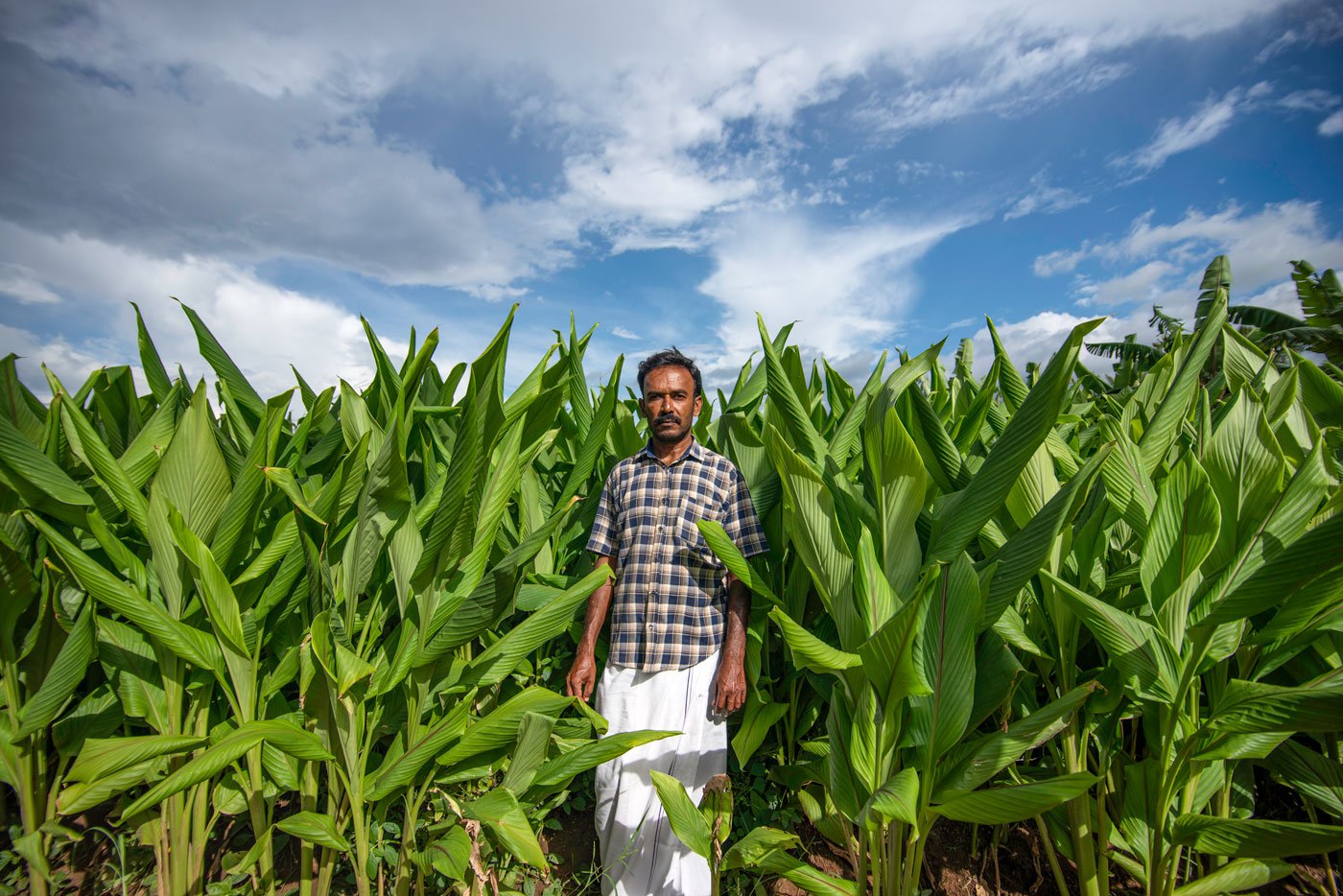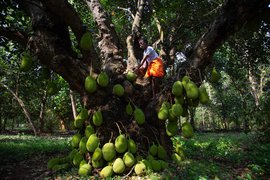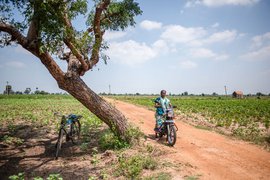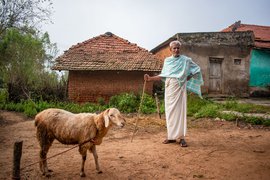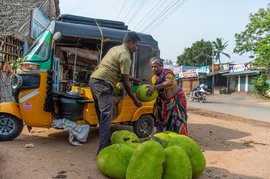For his father’s death anniversary,
Thiru Murthy makes an unusual offering: ten types of soap, many varieties of
coconut oil and his star product: turmeric powder. This, besides a hand of red
bananas, flowers, coconut, and a lit camphor, before Sundaramurthy’s garlanded
portrait.
“What could be a better tribute for Appa?” he asks, in a Facebook post. His father had given up farming manjal (turmeric). Thiru took it up when everybody advised him against it. “They told me to raise malli (jasmine), because flowers fetch a daily income. They laughed at me when I planted manjal ,” he smiles. Thiru proved them all wrong. His story is a rare one: a turmeric triumph.
Thiru Murthy, 43, farms 12 acres of land that he jointly owns with his elder brother in Uppupallam hamlet, Bhavanisagar block in Tamil Nadu’s Erode district. He raises three crops – turmeric, banana and coconut. But he does not sell them wholesale. It would be pointless, he says, when he has no control over the prices. Locally, nationally and internationally, it is the bigger traders, corporates and governments that fix rates.
India is the world’s biggest player in the thriving turmeric market. Exports in 2019 touched $190 million – that’s 62.6 per cent of the global trade. The catch: India is also an importer – the second highest, at 11.3 per cent. This major surge in imports over the past few years has hurt the interests of Indian turmeric growers.
The domestic markets – the mandis in Erode – already squeeze them. Big traders and buyers decide the value. There is no preferential pricing for organic produce, plus, there’s a huge year-on-year volatility. In 2011, the crop fetched a whopping Rs. 17,000 per quintal. The next year, it dropped to almost a fourth of that price. The 2021 average was around Rs. 7,000 a quintal.
With ingenuity, perseverance and a social media account, Thiru found a straightforward solution: value addition. While his effort may not be widely replicable, it was quite an achievement. “A single coconut that can fetch 10 rupees at the farm gate, earns me three times more, all because I press it for oil, and then make it into soap. It’s the same story with turmeric,” he explains. “I raise that on 1.5 acres. If I have to sell 3,000 kilos at the mandi , I will make a loss of nearly 50 rupees on every kilo of organic turmeric.”
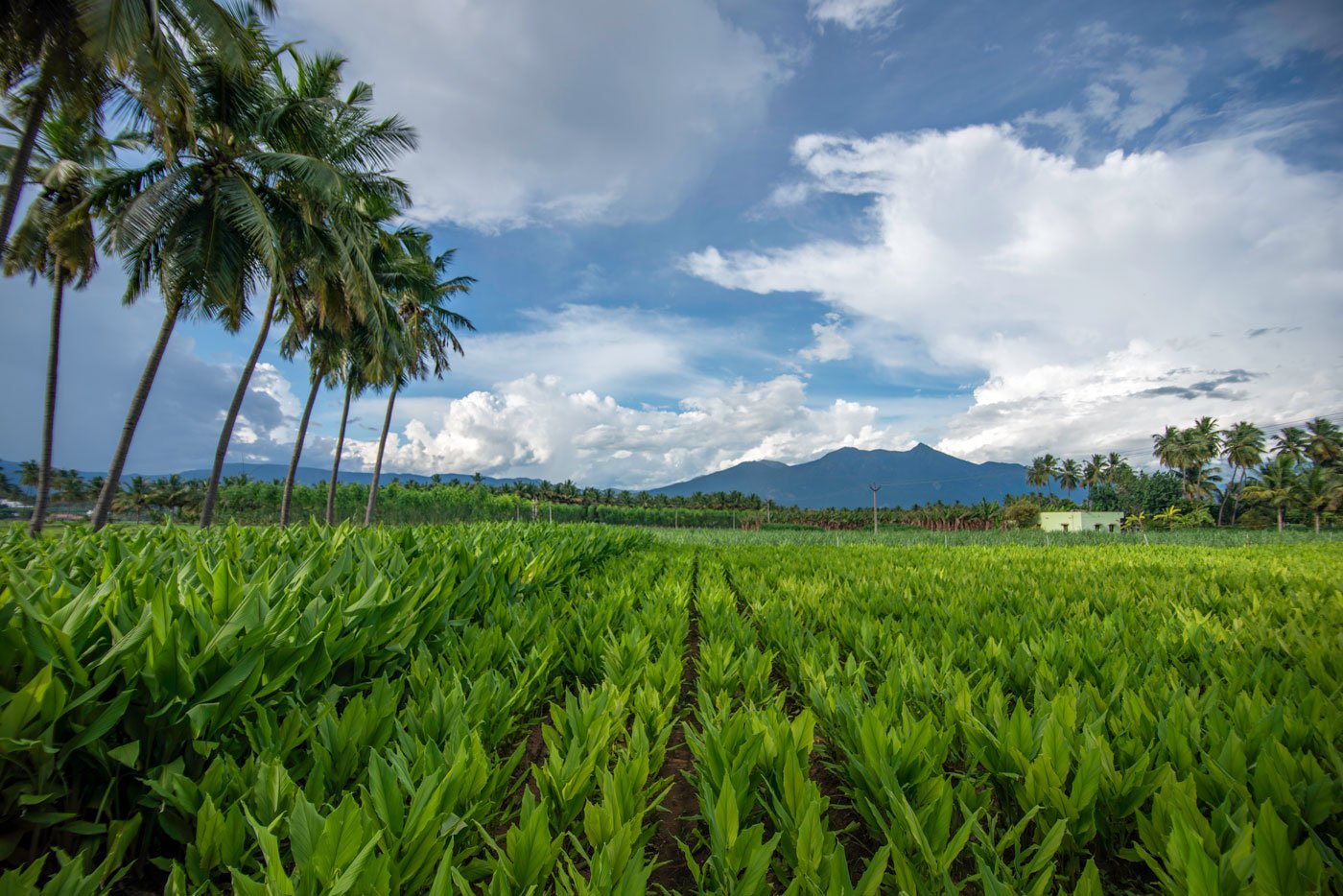

Left: Two types of turmeric grow in Thiru Murthy's fields at the foothills of the Sathyamangalam hills in Erode. Right: Thiru at home with his children and a relative’s son
Choosing the organic route means his cost of
production is much higher than that of cultivators going in for chemical-based
agriculture. Yet, he’s doing a lot better than his neighbours.
At the foothills of the Sathyamangalam range in Erode, his farm is the very definition of pastoral: a row of purple hills, each wearing a cap of rain clouds, rise behind the emerald fields. His turmeric plants are tall, their broad leaves drenched in both a gentle rain and an October sun. Tailorbirds nest on the coconut trees that line the field; they chirp loudly, and race around the fronds. It’s so lovely, that they side-track from his struggles as a farmer. Later, he talks about it slowly, carefully, sitting in his pink-walled house, on a grey cement floor, his four-year-old daughter on his lap, her silver anklets making a musical, chal, chal, chal …
“I can only see a profit if I sell it as half kilo and one kilo packets to my customers. And as soaps, oils and milk drinks.” In other words, he adds value to all that he produces. Like every turmeric farmer, he painstakingly boils, dries, and polishes his harvest. But while they’d store it – waiting for a better price – or sell it at the mandi , Thiru shifts it to his own godown.
Next, he powders the turmeric ‘bulb’ and ‘fingers’ in small batches. With a little more innovation – converting it into beauty products and malted drinks – he earns an additional Rs. 150 a kilo.
“But I don’t just keep all the money,” he points out. He ploughs it back into the land he loves. His farm not only supports his family, but also generates employment in the area. “There’s work for five men and three women daily in my farm during the peak season. Their wages are 400 and 300 rupees a head respectively, plus tea and bonda [a savoury snack]. I remember when the annual turmeric harvest cost a tenth of the 40,000 rupees per acre it does now. When I ask the labourers, they say petrol is 100 rupees a litre, a quarter of liquor [180 ml] is 140…” and he laughs. None of this, however, seems to boost the price of turmeric.
*****
Work song of women husking millet grains,
Drums sounded by farmers guarding Yam and Turmeric
To chase away foraging wild boars,
All these sounds echo in the mountains
From the Sangam-era poem
Malaipadu Kadaam
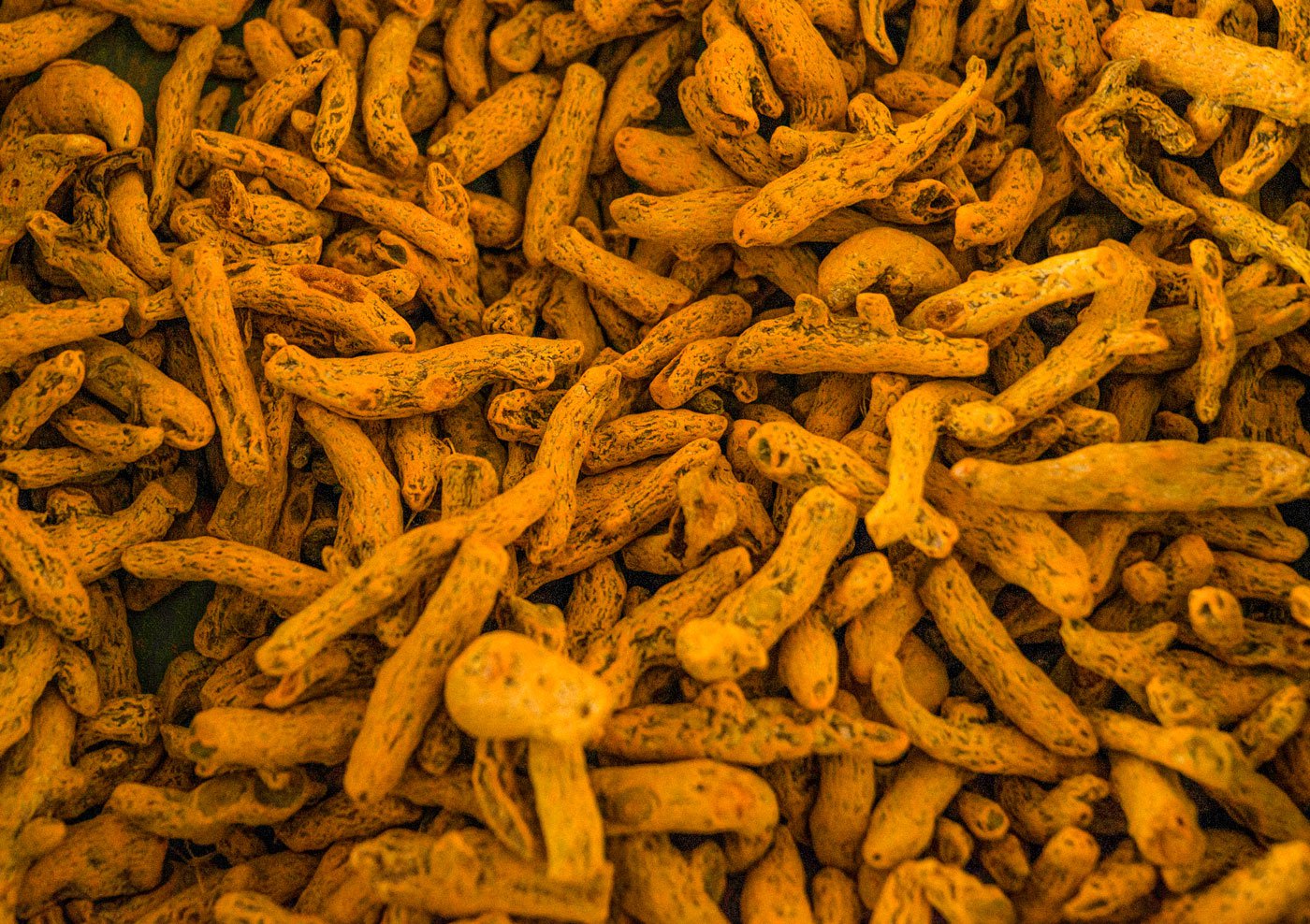
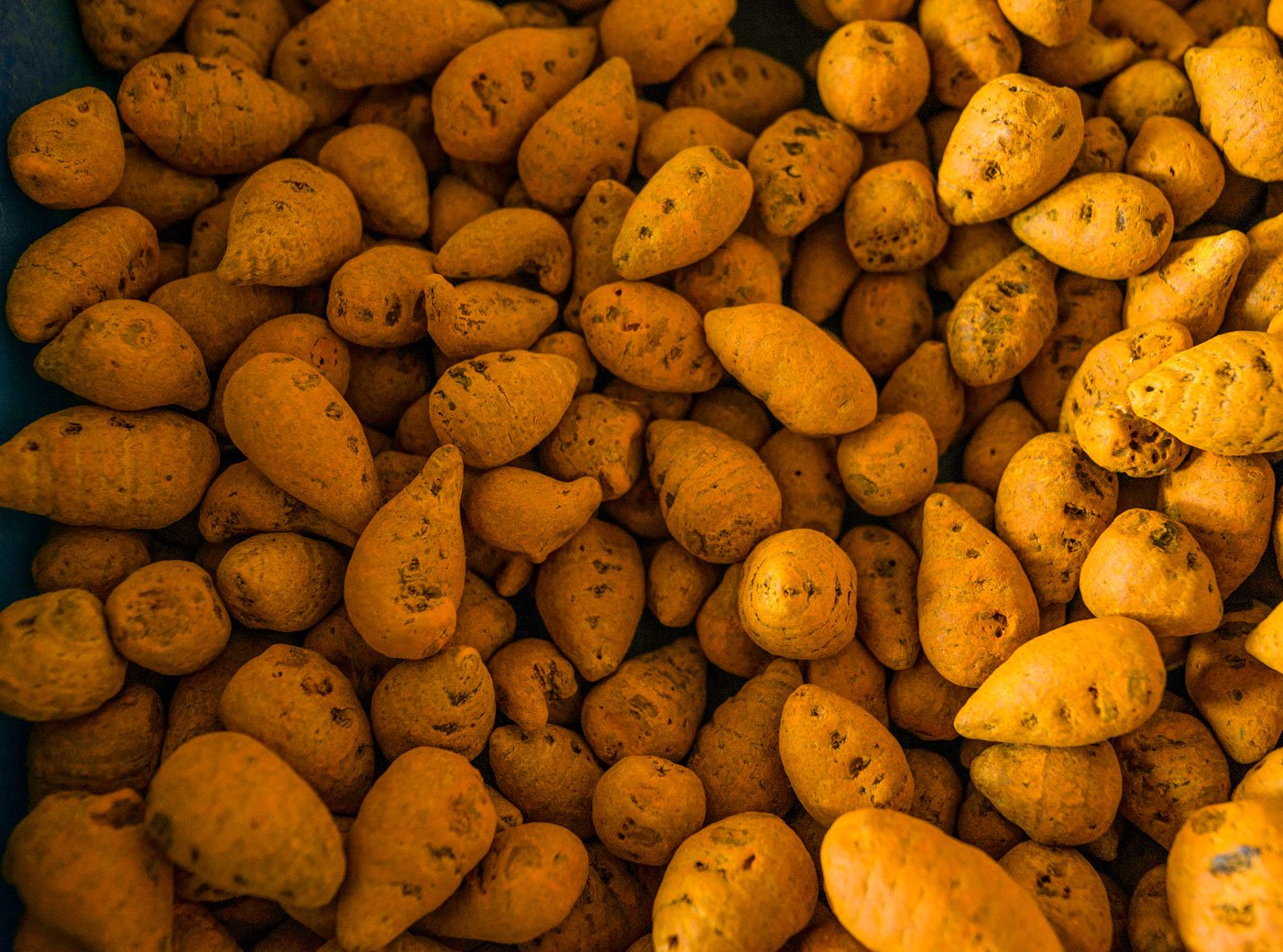
Trays with the lots of turmeric fingers and bulbs displayed at an auction in the regulated market in Perundurai, near Erode
Tamil Nadu and turmeric have an association going back 2,000 years, points out writer Chenthil Nathan, who translated those lines in his blog, OldTamilPoetry.com . The Malaipadu Kadaam , he says, is, “one of the 10 long poems in Sangam canon.”
The hero of the Indian kitchen, turmeric ( Curcuma longa) is closely related to ginger. The underground stem (rhizome), consisting of the central ‘bulb’ and branching ‘fingers’ is used commercially. The bulbs and fingers are separated at harvest and processed. They are boiled, dried, cleaned and polished before they’re sold. Fingers fetch a higher price at the auction.
Turmeric is probably native to the country, says food historian K.T. Achaya in his book, Indian Food: A Historical Companion. “Its striking colour and dyeing ability gave haridra [its Sanskrit name] an important place in magic and ritual” in the country, he says. An everyday spice, manjal is widely used in cuisines and cultures across India. A pinch of turmeric powder colours food delicately, flavours it gently, and improves immunity. Curcumin, the bright yellow pigment, is extracted for its medicinal properties, chiefly antioxidant and anti-inflammatory .
Grandmothers figured out how it worked long before scientists did. They heated turmeric and pepper – which improved the bioavailability of curcumin – with milk, and served it up when anybody in the family sniffled. Starbucks now has a recipe for ‘golden turmeric latte,’ of which my grandma may or may not approve. It involves oat milk and a fancy frothing machine and vanilla.
Turmeric is considered auspicious. Married women in the south wear a thread that’s dyed with turmeric around their necks. Manjal neeratu vizha (‘turmeric bathing ceremony’) is a puberty ritual that is celebrated (sometimes with large flex boards and a big crowd) to mark a young girl’s first period. Manjal was also a well-known antiseptic, and a paste was applied on open sores and skin lesions. Pet care brands use it in their products for the same reason.
When US researchers patented turmeric, the Indian Council of Scientific and Industrial Research (CSIR) hired a lawyer for $15,000 in 1997 and argued that since it was used for centuries in the country for wound healing, it “lacked the ‘novelty’ criterion required for patenting.” The CSIR got the United States Patent and Trademark Office to revoke the “contentious patent” on turmeric.
Sivaji Ganesan would have approved. The famous actor played the role of anti-colonial hero Veerapandiya Kattabomman in the 1959 film of the same name – the first in Tamil cinema to win international awards for best film and best actor. Kattabomman’s stinging line as he rejects the British order to pay them taxes: “Why? Have you served the women of my community by grinding turmeric for them?”
*****
“I’m harvesting the hard work of my father.”
Thiru Murthy, turmeric grower in Erode
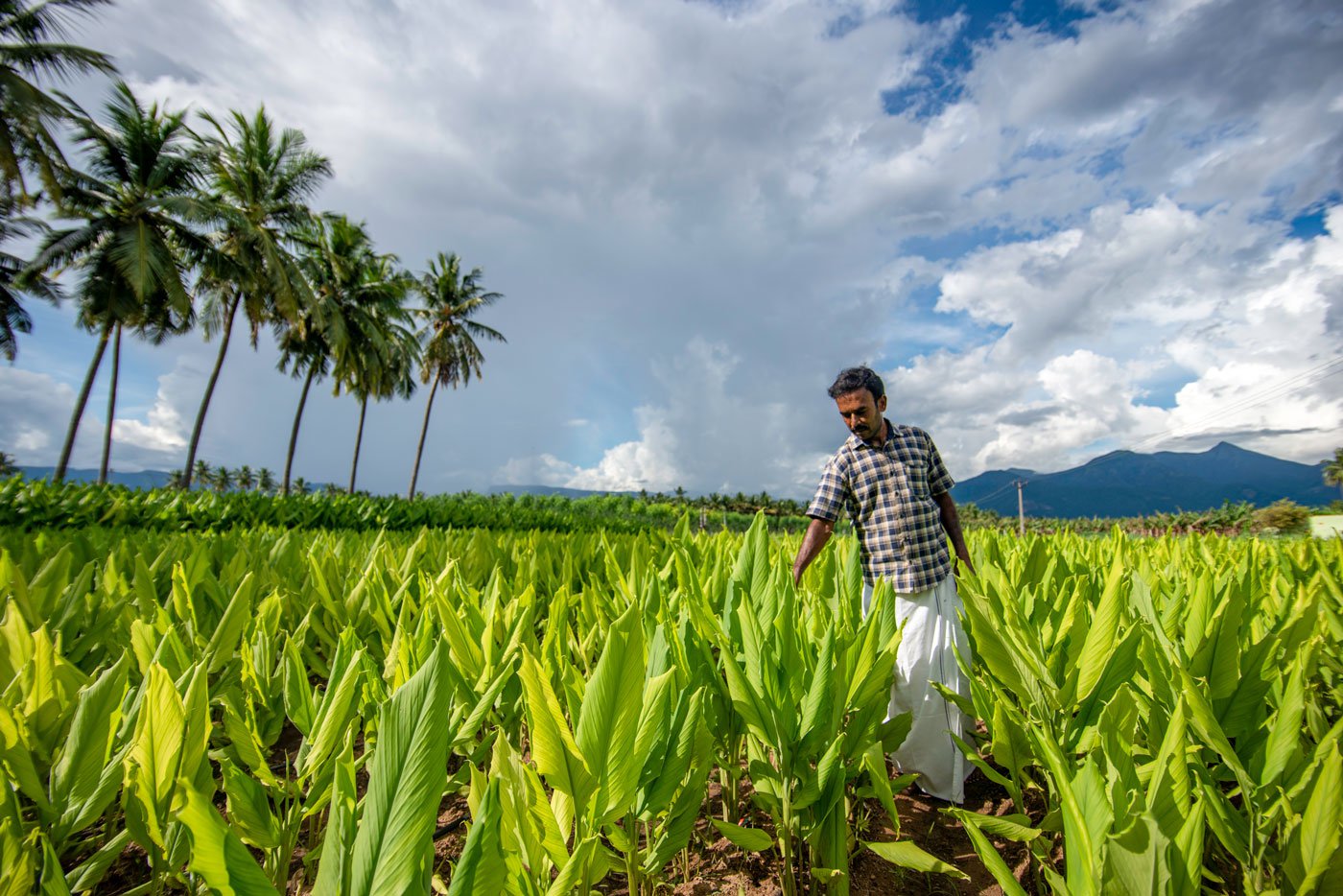
Thiru inspecting the turmeric plants in his farm, in
Uppupallam hamlet of Erode's Bhavanisagar block
He has farmed for a living off and on since he was 18, he told PARI during our second visit to Sathyamangalam, in October 2021. Our first one was during the turmeric harvest in March the same year. Walking between the swaying turmeric plants, the tip of his white dhoti in his hands, he talks about his journey.
“Appa moved to Uppupallam – this is Amma’s native place – and bought land for just ten or twenty
thousand rupees an acre in the ’70s. Now the same goes for 40 lakhs. You can’t
buy 10 acres anymore!” A tenth class dropout, Thiru became a full-time organic
farmer in 2009. He was 31 at the time.
It wasn’t his first choice though. He
had tried many jobs. First he had a
maligai kadai
, a provision store, at
home. He sold
elandha vadai
(sweet-and-sour jujube fruit
vada
),
thinpandam
(snacks), rice,
cigarettes,
beedis
, and during
Deepavali, firecrackers. His zeal for business took him through many – he was a
cable TV service provider, he sold milk, then he went to Bengaluru where his
elder sister lived. There, he ran a two-wheeler service station, worked in a
small finance company giving out loans, and finally, he bought and sold cars.
“I tried six jobs in 14 years. It was extremely difficult; I struggled and
burnt my fingers.”
He calls the Bengaluru period the dog
days, “
naai padadha paadu
,” comparing it with the hardships of a
mongrel. He earned little and shared a 6 x 10 foot room with a friend, paying
Rs. 2,500 for that cramped space.
“When I came back to Sathyamangalam
in March 2009, I got crazy about agriculture.” He continued with sugarcane –
which his father cropped – added tapioca and a plot of onions.
“I made mistakes and learnt from them. In 2010, seed onion was 80 rupees a kilo. During the harvest, it fell to 11 rupees. Marana adi [death blow],” he sighs. It helped that he had other crops to hedge his loss. In 2014 – two years after his father died, and nine years after his family stopped raising it – he planted manjal.
*****
Someone is making money on turmeric. It’s not always the farmer…
Turmeric growers in Erode
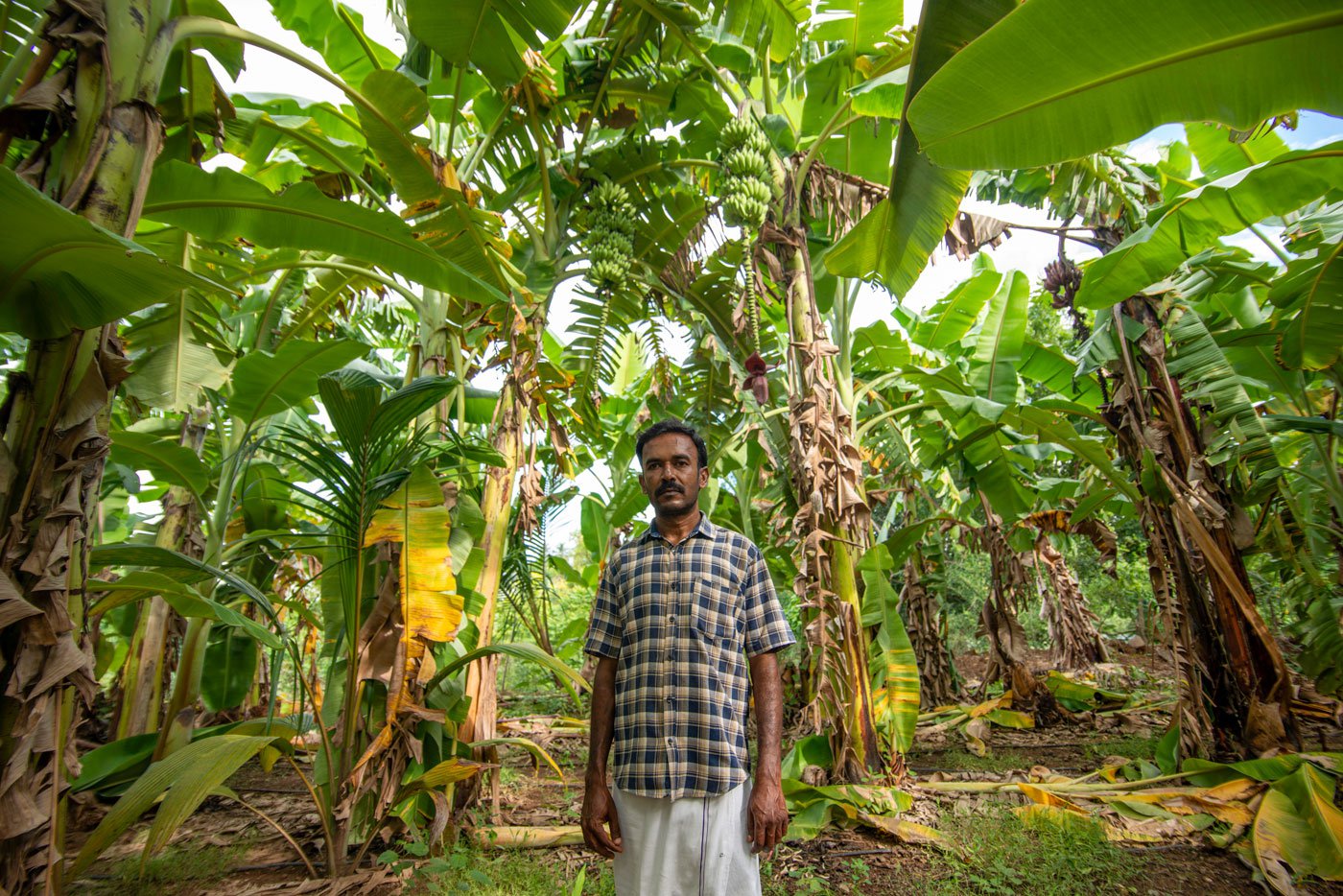
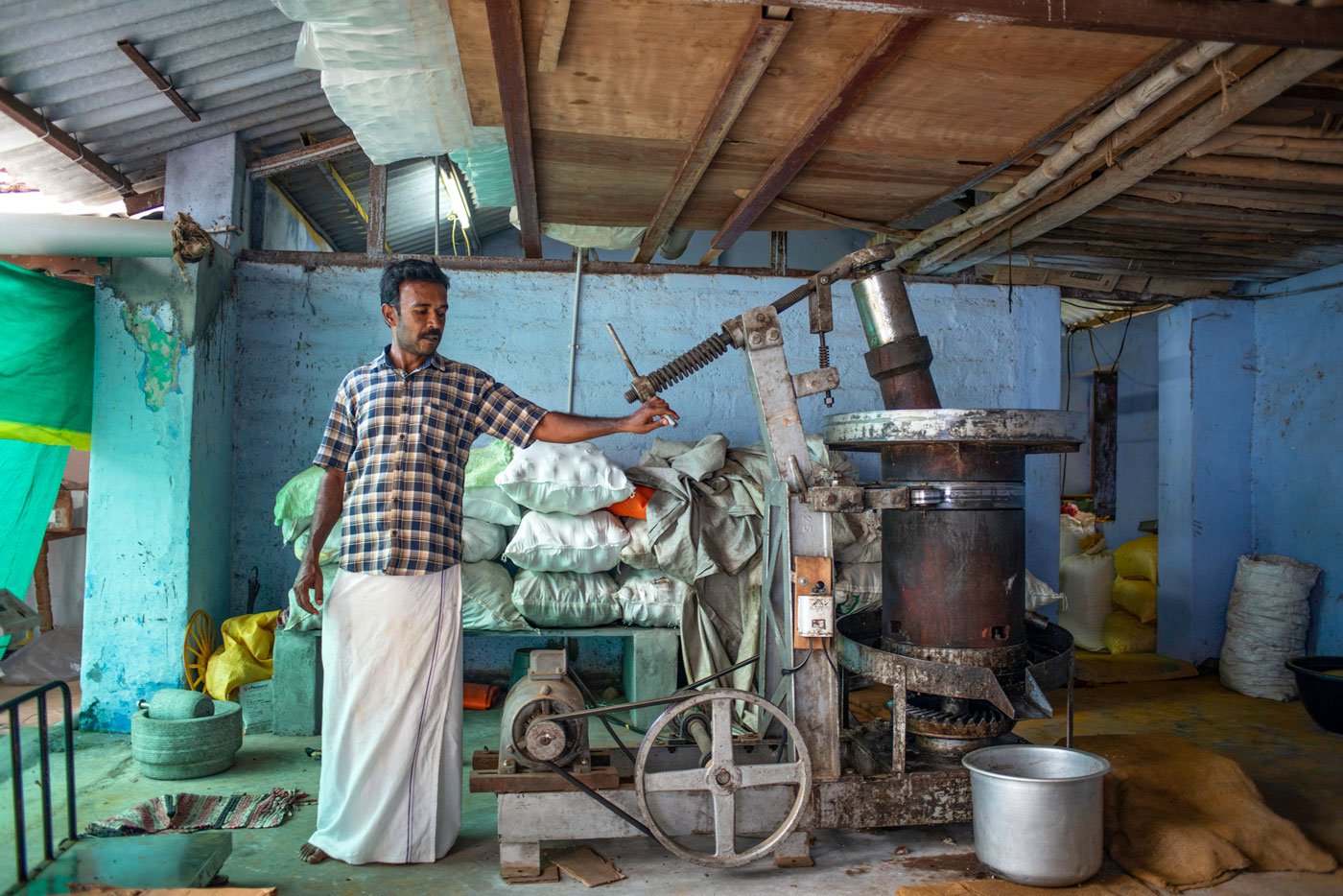
Left: In his banana field, Thiru has planted the red variety this time. Right: The wooden
chekku
in which coconut oil is cold-pressed
to
make fragrant hair oils
Turmeric is cultivated on over 51,000 acres across Tamil Nadu, totalling a production of more than 86,000 tons, earning it fourth place in the country. Erode district leads the tally within the state, with 12,570 acres of manjal .
Thiru’s 1.5 acres is a drop in that ocean. He started out in June 2014 growing manjal on a tiny half-acre plot and switched to coconut and banana in the rest of his farmland. He was encouraged when he sold his harvest – one ton of turmeric – quickly. About a third – 300 kilos of turmeric – was powdered and retailed through his Facebook contacts in 10 days flat. He named his venture ‘Yer Munai,’ meaning ploughshare, “because the tool is unrivalled.” The logo is the classic image: a man, a plough and two bullocks. It was a success.
Encouraged, he eagerly cultivated manjal on two and a half acres the next year, harvested a good five thousand kilos, and was stuck with four-fifths of his output for months. He tried, but could not get it certified as organic – a punishing process, that’s both expensive and exasperating – and ended up selling it to a big masala company in Erode. They gave him only a thundu cheetu, a small slip with the calculations: 8,100 rupees for a quintal, and a week later, an out-of-state cheque that was post-dated 15 days.
It took Thiru weeks to get the cheque cleared – that was the year of the demonetisation. “Since 2017,” he says, “I’m careful and only cultivate one or one-and-a-half acres of turmeric. And, every other year, I leave it fallow, to give the earth ‘rest’.”
In January, he begins preparing the beds, and crops – two rounds of millets – for 45 days each. This is ploughed back into the soil, to fix nitrogen and nutrients. That, he explains, costs Rs.15,000. Next, he lays out drip irrigation, prepares the bed for turmeric, and that’s another Rs. 15,000. The cost of bulbs – he needs 800 kilos for an acre – comes to Rs. 24,000 at Rs. 40 a kilo. The labour charge involved costs Rs. 5,000 an acre. A month later, when the seeds sprout, he applies two tons of goat-dung manure – which he swears works better than cow dung for this crop – which he has purchased for Rs. 14,000.
Then there are about six rounds of weeding, at Rs. 10,000 each (that is, Rs. 300 a day paid to 30 or 35 women per acre). In March, the harvesting costs around Rs. 40,000, and is a “fixed contract. Usually, a team of around 20 men and 50 women come. They finish in a day. If the harvest is especially good, they ask for 5,000 more.”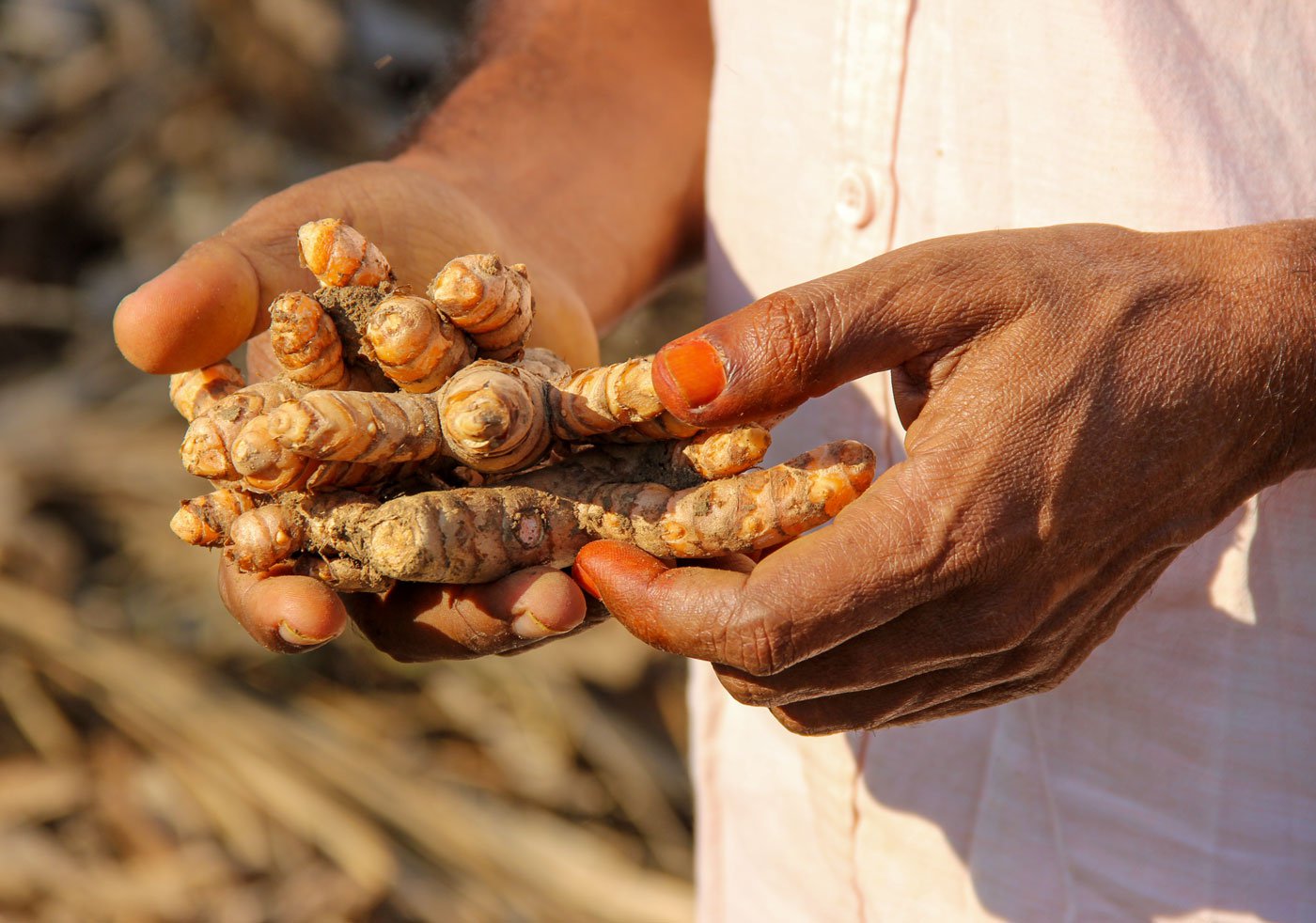
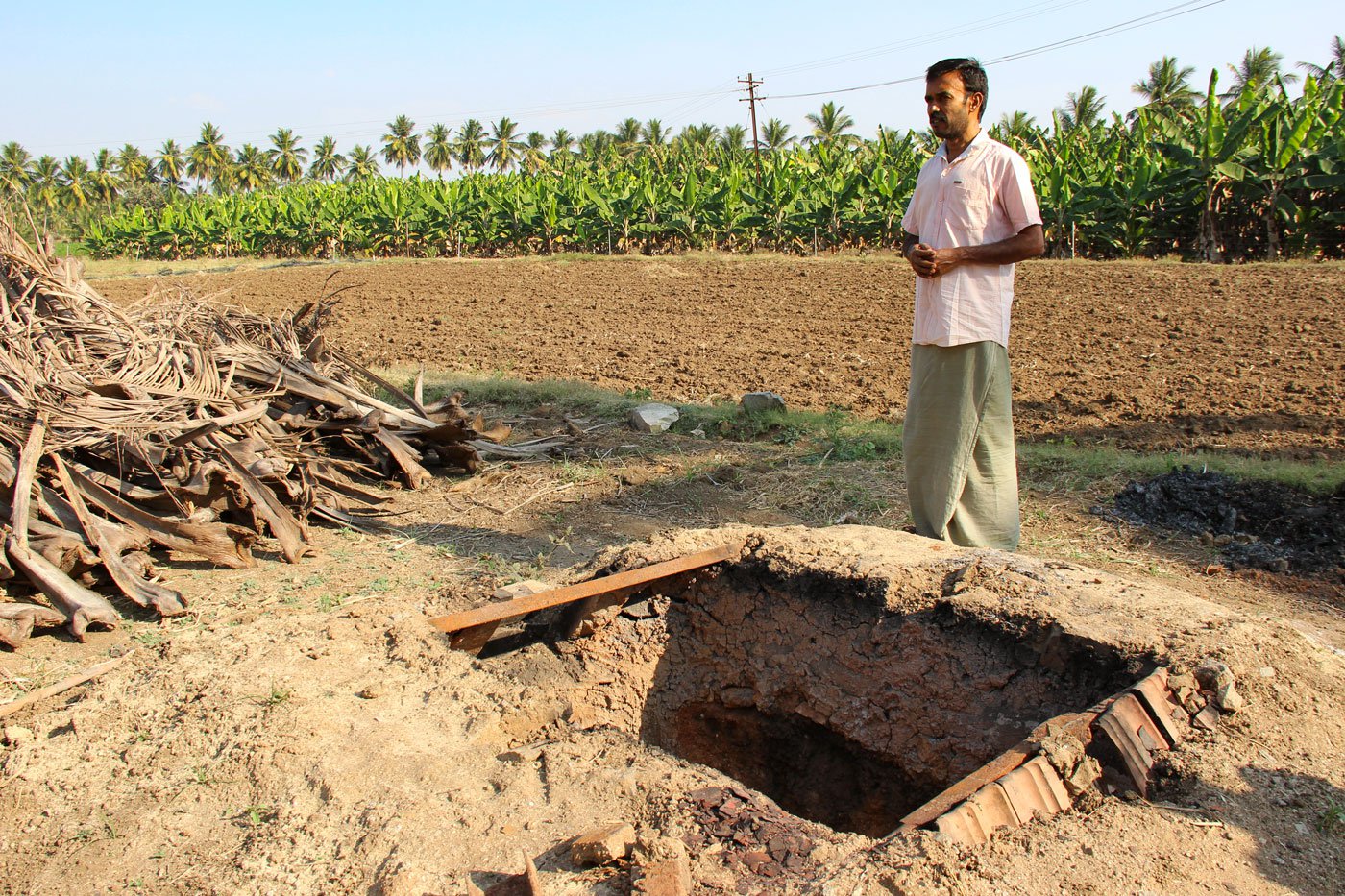
Left: Fresh turmeric fingers, which are processed by Thiru Murthy to make beauty products and malted drinks. Right: The purpose-built pit for boiling the turmeric
Finally, the fresh turmeric is boiled, dried and polished. For this reporter, that’s one line of text, but for the farm it is many days of intensive, skilled work, adding Rs. 65,000 to the production cost. And while the expenditure column keeps going up, the weight of the turmeric comes down by nearly half.
Ten months and 238,000 rupees later, he has about 2,000 kilos of dried turmeric (from an acre) to sell. The production cost comes to 119 rupees a kilo. (Other farmers, like K.N. Sellamuthu from Kodumudi, also into organic cultivation, estimate their cost to be around Rs. 80 a kilo, by growing higher yield varieties with methods that are less time and skill intensive).
Thiru prices his turmeric powder strategically. He spends Rs. 40 to powder a kilo, and packaging and courier charges add another 40.
Shops that buy in bulk, that is, 20 kilos, get it at 300 rupees a kilo. At the farm gate, it goes for 400 rupees, and when it is shipped within India, that’s 500. Other brands price their organic manjal upwards of 375 rupees per kilo, all the way up to 1,000 a kilo. At the Erode mandi , traders pick up a kilo of dried turmeric – that’s 950 grams when powdered – for 70 rupees. And may part with it for three times as much.
*****
“Without a sickle, gun or baton, corporates have beaten down farmers.”
P.K. Deivasigamani, president, Turmeric Farmers Association of India
“I tried, I fought, but I wasn’t able to fix a fair price for turmeric,” says TFAI president Deivasigamani. PARI met him at his house near Erode on a rainy October evening. “Governments are marching towards corporates, and corporates are making the governments. Until that changes, farmers – not just small, turmeric farmers – don’t have a future… It is the same in America. Farming is not profitable. They will tell you in English there, we say it in Tamil here,” he says.
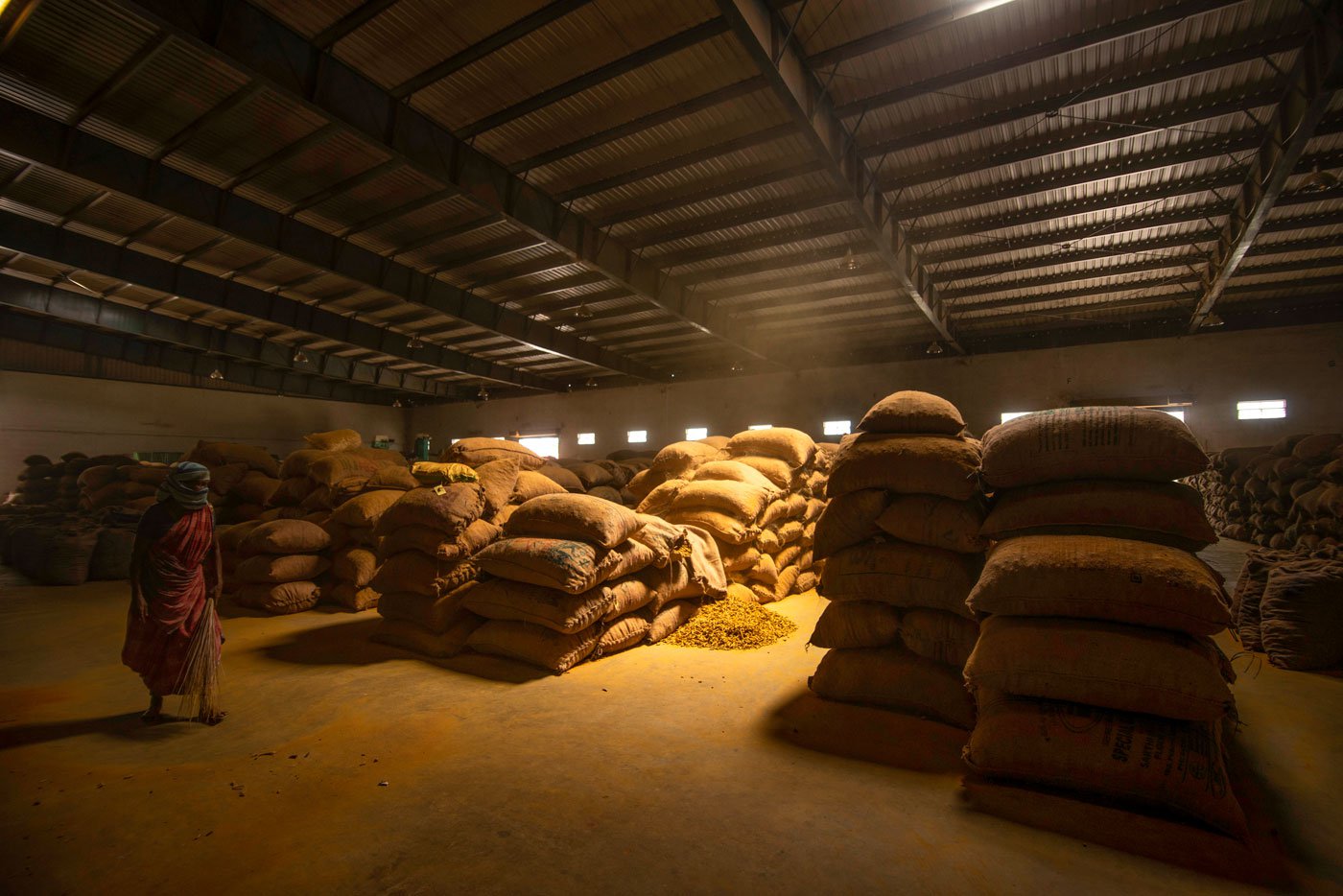
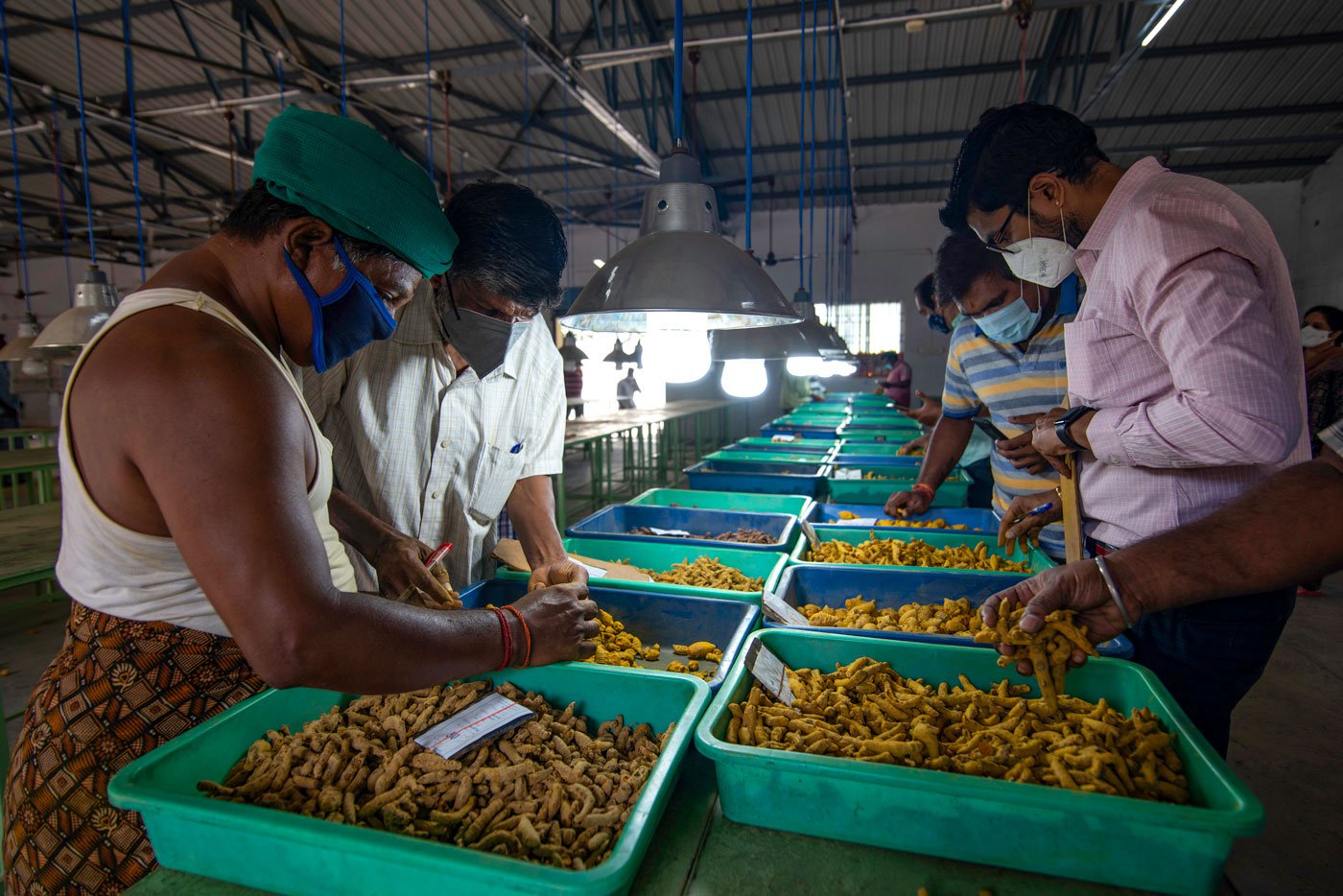
Left: Inside the storage yard of the Perundurai regulated market. Right: Buyers at the auction inspect the turmeric lots
“Corporates have replaced the feudal system and are the new giant landlords. With scale and size on their side, they can process hundreds of tons. How does a small farmer with a few tons compete with them on price?”
At the Perundurai regulated market complex near Erode, a daily auction determines the fate of turmeric farmers. Dealing solely with turmeric, it has many stocking yards – which can store tens of thousands of sacks – and an auction shed. When PARI attended the auction, on October 11, the ‘top rate’ for a quintal of turmeric finger was Rs. 7,449, and for the bulb, Rs. 6,669. Traders always end the quoted price with ‘9’. That is because of their belief in numerology, explains market supervisor Aravind Palanisamy.
Samples from 50 lots of turmeric are on display in plastic trays. Traders sift through each tray and break, smell, even bounce the samples on the floor! They weigh and let it fall between their fingers. They make notes, they place a bid. C. Anandakumar, from the purchase department of a major masala company, explained that he only took “the first quality.” Today, he’s picked up 23 of the 459 bags these samples represent.
The annual turnover of the market is Rs. 40 crores, Aravind tells me in his office right next to the mandi . L. Rasina from Kodumudi was sitting on the cement staircase to the shed. She had only been offered Rs. 5,489 a quintal for the 30 quintals she has brought along.
With no storage facility of her own, she always brings her harvest to the government godown where storing it costs her 20 paise per quintal per day. Some farmers wait up to four years for a decent price. Seven months and five trips later, from when she began, Rasina decides she will sell. At a loss.
Many farmers in the Kongu belt – which comprises of Erode, Coimbatore and Salem districts – treat agriculture as an additional occupation, says Deivasigamani. “If they relied only on it, they’d struggle.”
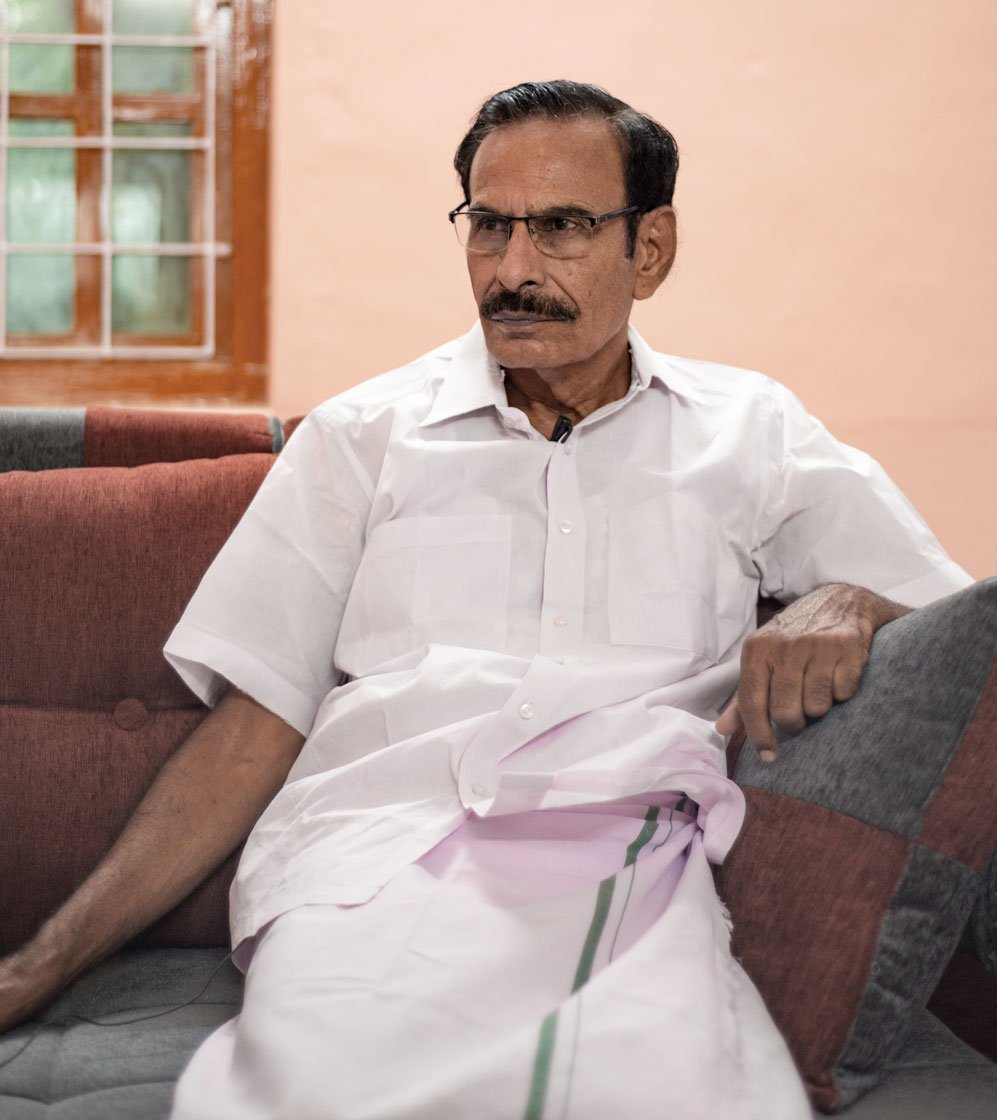
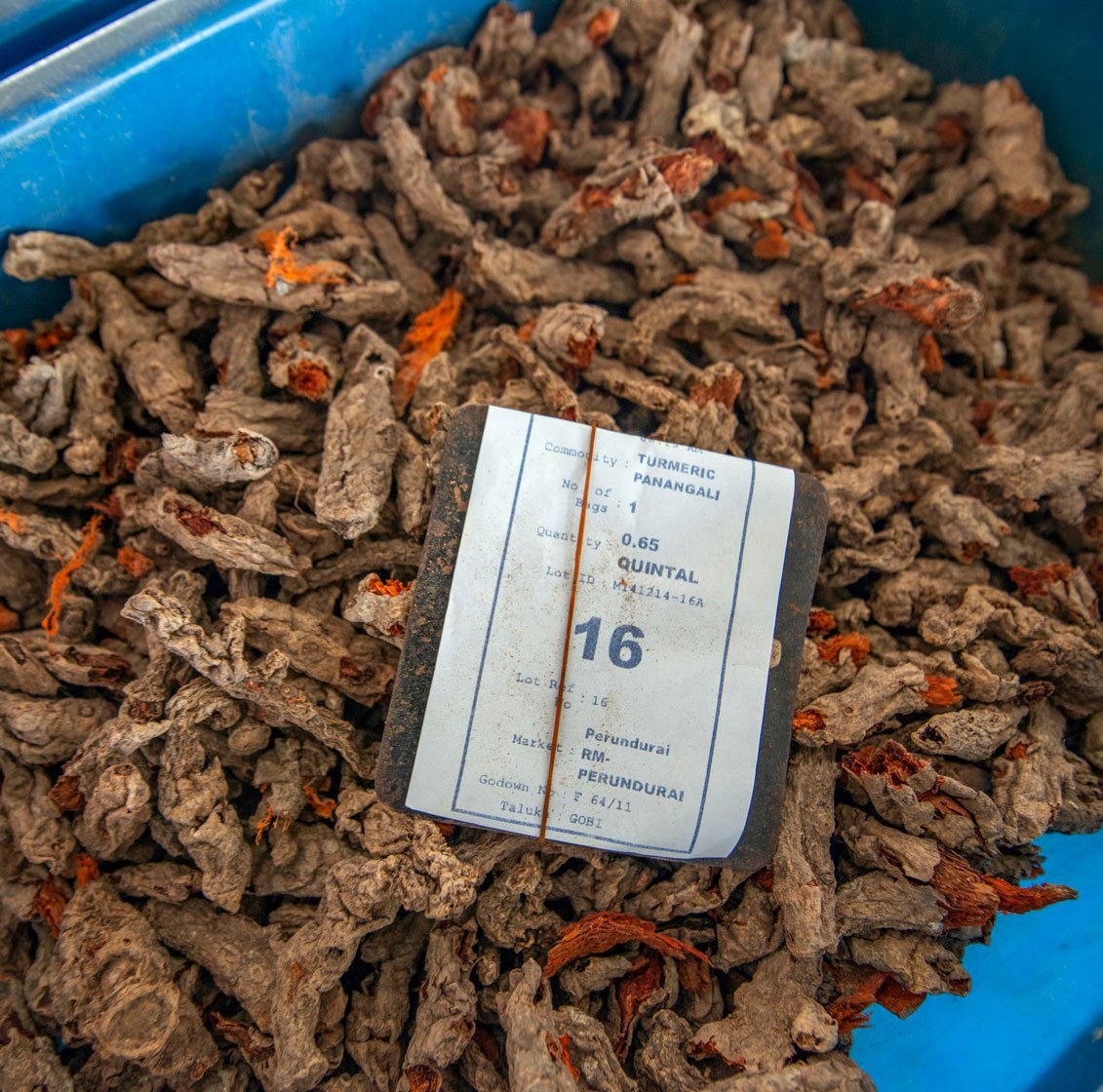
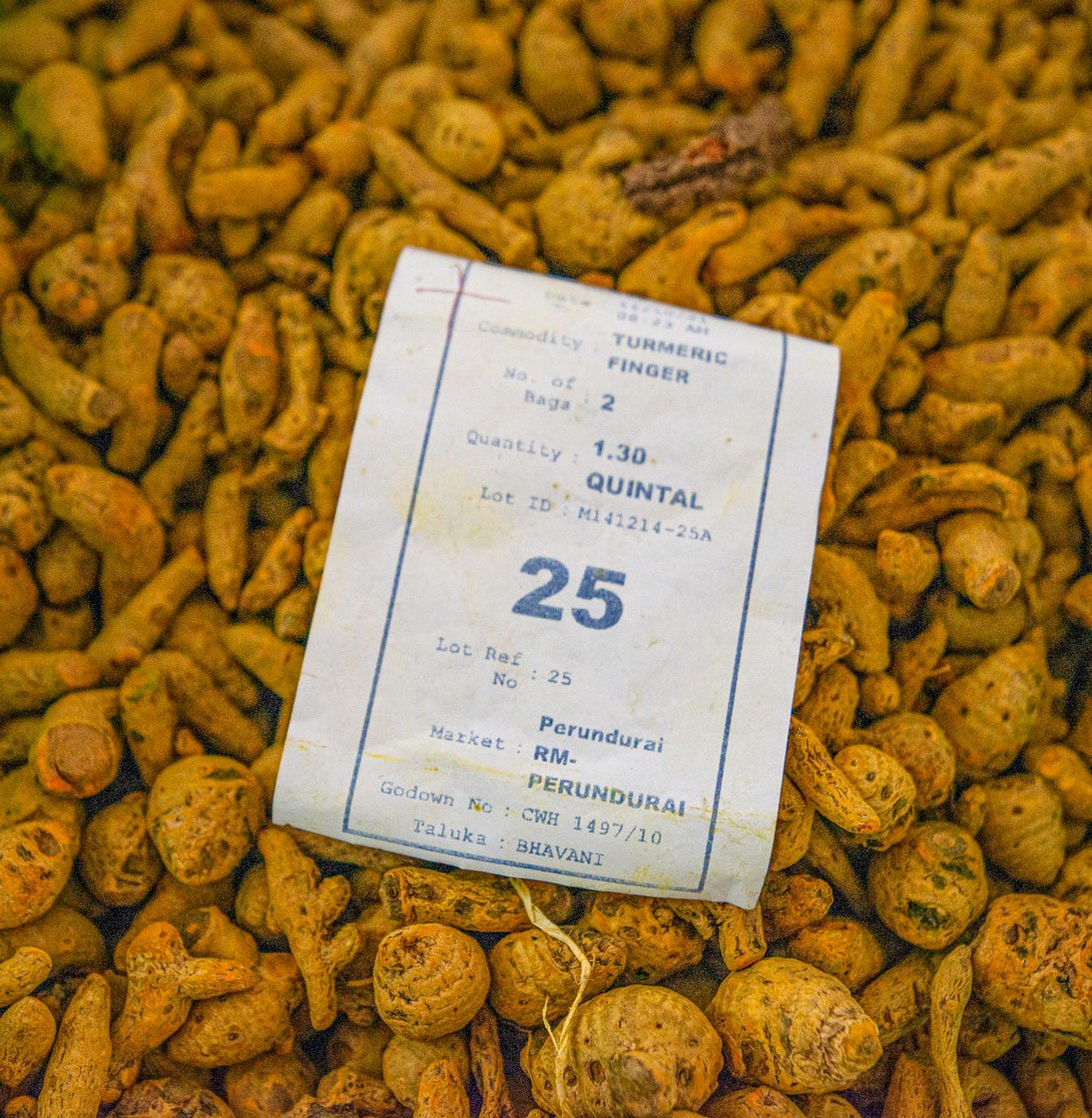
Left: P.K. Deivasigamani, president of the turmeric farmers' association. Centre and right: Labels on the samples exhibited at the turmeric auction
He estimates there are 25,000 to 50,000 farmers who plant turmeric in Tamil Nadu, depending on the price. If one quintal is sold for Rs. 17,000 (as it once was), there will be “5 crore turmeric farmers,” he laughs. “And when that falls to 5,000 a quintal, you’ll have barely 10,000 farmers.”
Deivasigamani has a suggestion: diversify. “Stop raising turmeric in such huge quantities,” he says. “If there’s less production, we may get a good price.”
*****
“Instead of hybrids – which give bigger yields – go for native varieties.”
Thiru Murthy, turmeric farmer in Erode
In March last year, he had just harvested his two tons of crop – a brown hillock covered with wilting turmeric leaves, waiting for the team that would boil and dry it. Thiru isn’t averse to modernity: he uses solar power, and champions it. He also believes in heritage varieties and is pleased that the Geographical Indication was given for an ‘Erode Local’ variety of turmeric.
He criticises research institutes that are only worried about yields. Focussing on a bigger harvest only increases the expenditure on chemical fertilisers. “Why can’t the government help us sell our produce for a fair price?” Policy makers need first-hand knowledge, he argues. His wife and business partner Gomathy agrees. “Let students from agricultural universities come and work in our farm,” they both suggest. “If they don’t understand the real-world problems, they’ll only go about inventing hybrids.” Their grouse is understandable. Big, shiny hybrids fetch Rs. 200 more per quintal – but are grown with chemical intensive inputs.
When he began farming, cash flow was difficult. The return on annual crops like turmeric is realised well into the next year. Thiru is no longer eligible for a bank loan; his late father had taken a hefty one, with his son as surety. And he is still repaying that loan of Rs. 14 lakhs. To do which, he has borrowed from an informal source at “ rendu rupa vatti ” (interest of two rupees per hundred – per month). Or 24 per cent annually.
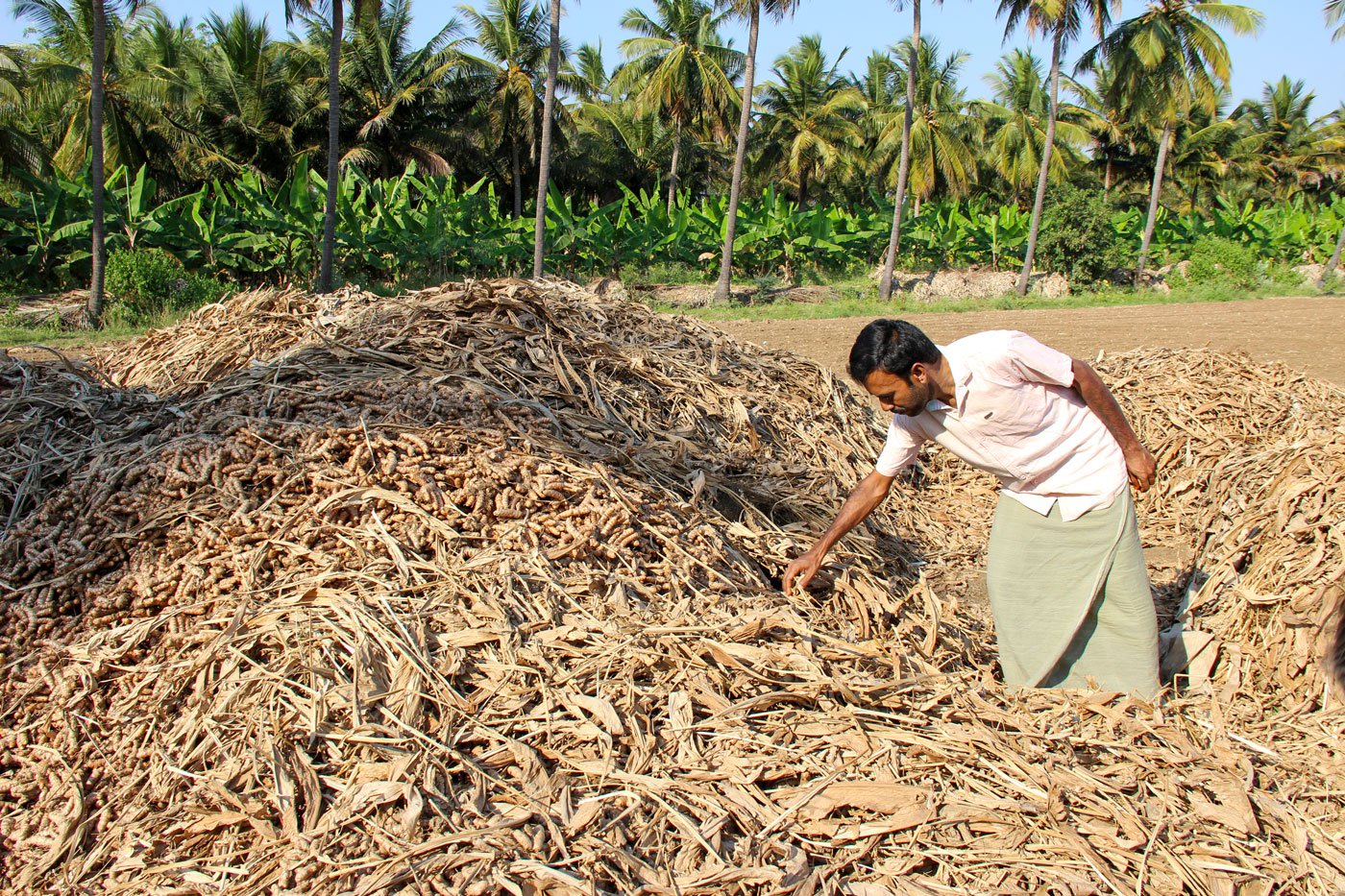
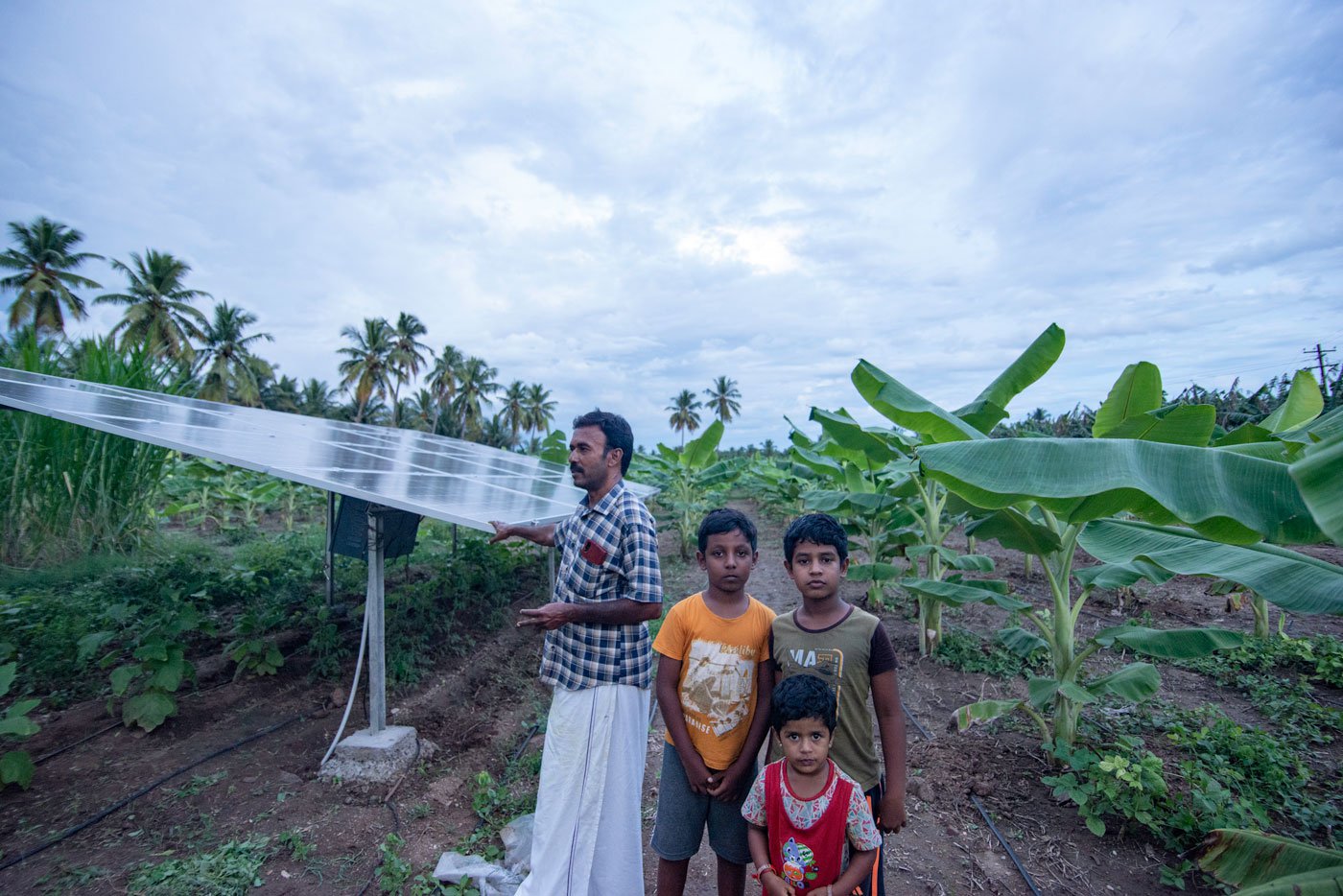
Left: The harvested turmeric is covered with dried leaves, waiting to be boiled, dried and polished. Right: Thiru uses solar power and champions it
“Some Facebook friends also loaned me money, without interest, for six months. Thankfully, I no longer need to borrow. I repaid my friends. But I’m still paying off my father’s bank loan.” He now makes Rs. 50,000 a month, for which three adults (Thiru, his mother and Gomathy) work up to 12 hours a day – but they don’t factor in the cost of family labour.
In the room where he powders manjal , Thiru scoops a handful of bulbs and holds them up. They’re a bright orange-yellow and hard as rock. So hard that it is hand pounded in a granite pestle before it is fed into the grinding machine. Else, it would break the metal blade of the grinder.
The room smells delightful, the fragrance of freshly ground turmeric is at once heady and comforting. Golden dust settles on everything: the electric grinding mill, the switch board; even the cobwebs wear tiny necklaces of turmeric dust.
A large circle of marudhani (henna), and smaller dots around it, make Thiru’s palm orange. His sinewy forearms tell the rest of the story, one of hard, physical labour. What is invisible are his extraordinary efforts to add value to his harvest and some costly experiments that fail. Like this year’s ginger crop, which was a disaster. But he views the Rs. 40,000 he lost on that as “a learning”. He tells me about that while Gomathy makes us hot bajji and tea.
*****
“Considering the importance of turmeric, it is planned to establish a new Research Centre for Turmeric in Bhavanisagar of Erode District in an area of about 100 acres.”
M.R.K. Paneerselvam, agriculture minister, Tamil Nadu
How is a farmer to succeed, when India exports its top quality turmeric at Rs. 93.5 a kilo and imports it at Rs. 86 per kilo? The 7-rupee difference not only squeezes the Indian farmer, but rapidly growing imports – twice what they were four years ago – removes any guarantee of a fair price in the future.
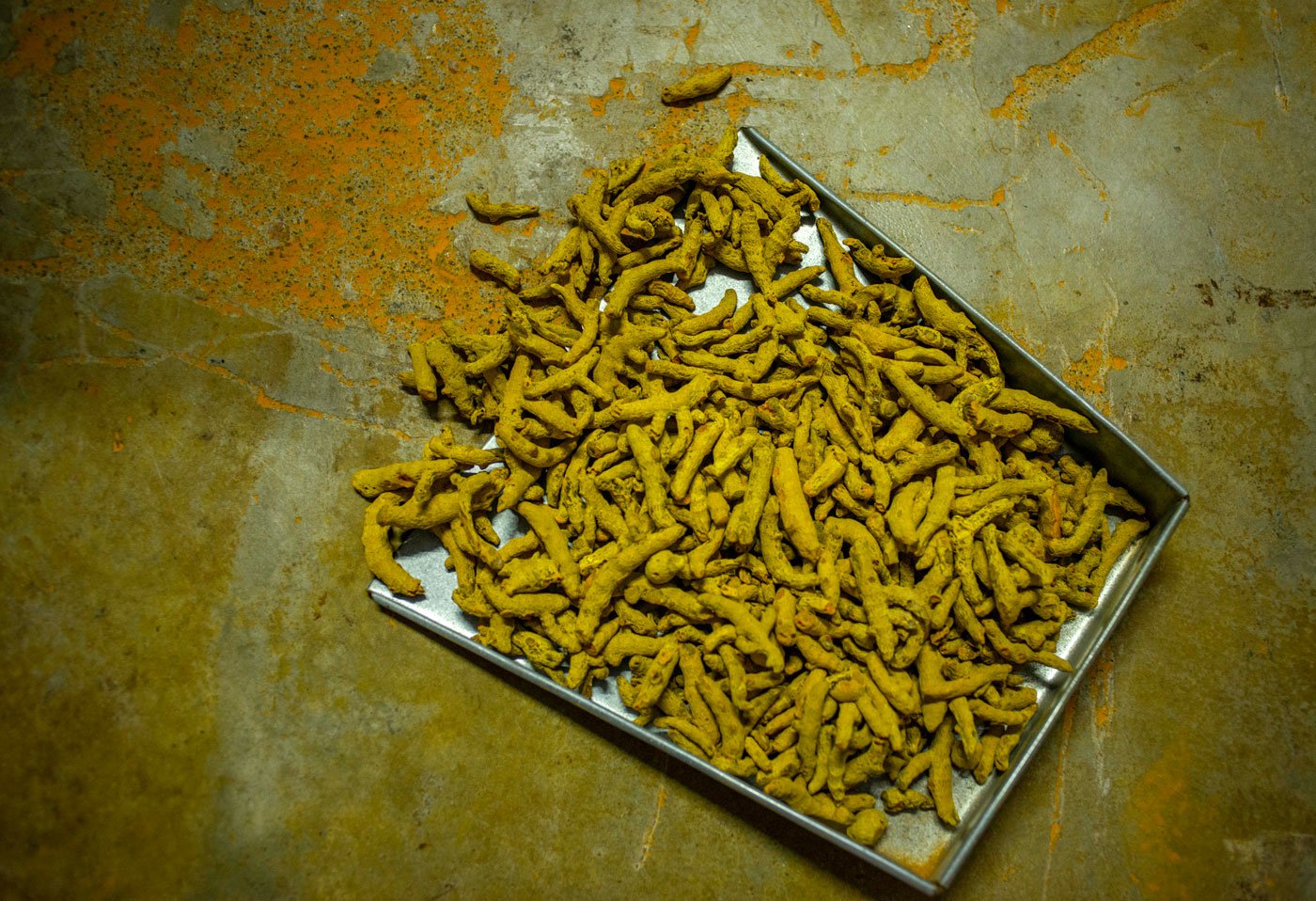
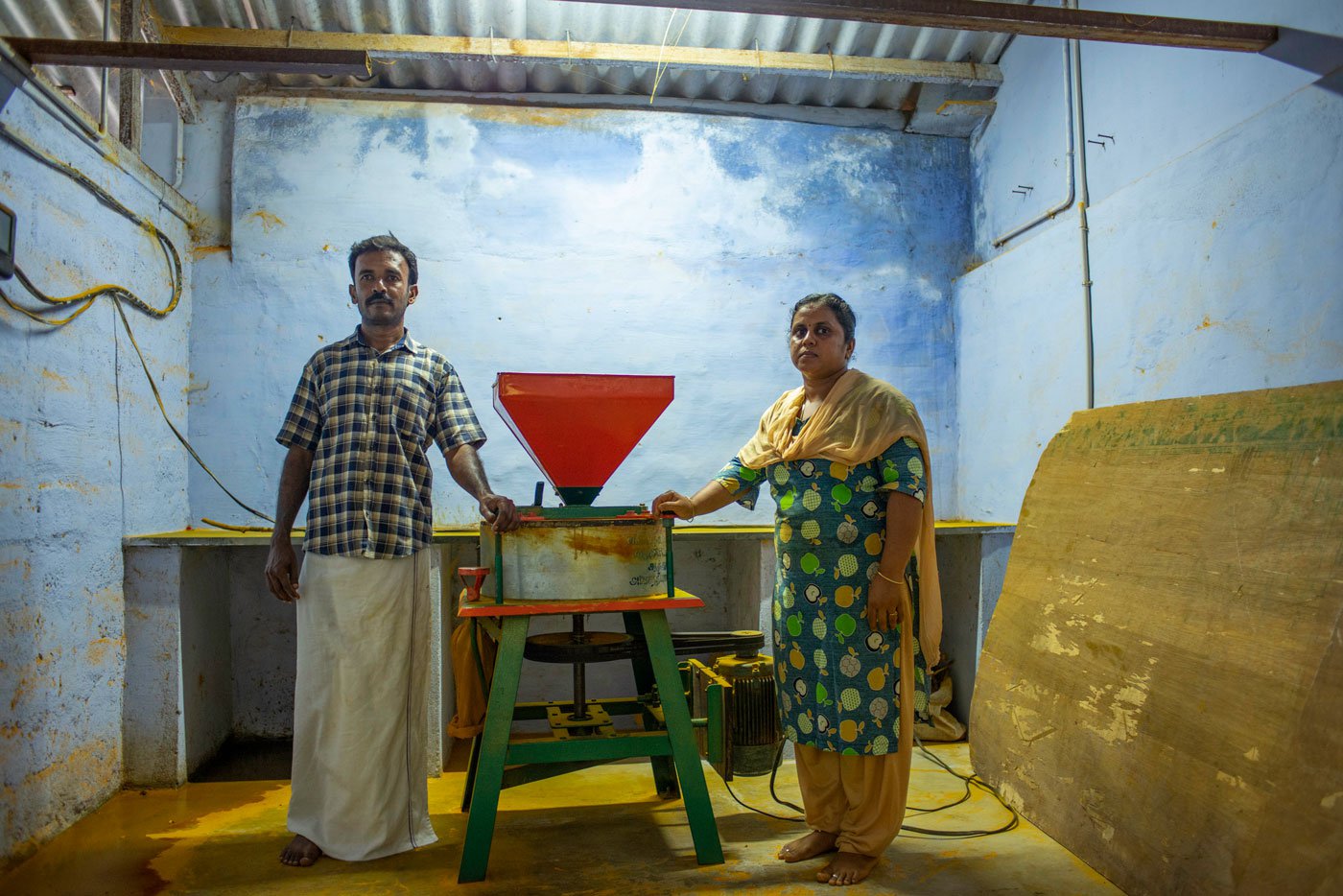
Left: A small batch of turmeric waiting to be cleaned. Right: Thiru Murthy and T. Gomathy with their electric grinding mill
The Tamil Nadu government acknowledges this in an official order: while India is the largest producer of turmeric, it imports from other countries “for want of varieties with high curcumin content,” says agriculture minister Paneerselvam.
While presenting a separate agriculture budget last August, Panneerselvam announced the decision to form a new research centre for turmeric, for which the state government would provide Rs. 2 crores. The state effectively promises to provide improved varieties, value addition and hands-on training, so that “farmers won’t shift their cultivation to another crop.”
Thiru Murthy’s own philosophy is simple: give the customer a great product. “If my product is good, 300 people will buy it, and tell 3,000 others. But if it is substandard stuff, the same 300 people will tell 30,000 others that it is bad.” Using social media – and word of mouth publicity – he sells their 3-ton manjal harvest over 10 months, averaging roughly 300 kilos a month. And he’s learnt some important lessons doing it. One, there is no preferential pay in the wholesale market for organic turmeric. And two, unless a farmer sells directly, he or she does not realise a good price.
Thiru processes turmeric in two ways. One is the traditional way of boiling, drying, and powdering the rhizome. He shows me the lab results – the curcumin content in this method is 3.6 per cent. The second method is unconventional, where the rhizome is sliced, dried in the sun and powdered. This logs curcumin at 8.6 per cent. He fails to see the clamour for a higher curcumin content though. “If it is for extraction in the pharma industry, it makes sense,” he argues. “Why do you need high percentages for food?”
He also sells fresh turmeric soon after the harvest. That goes for Rs. 40 rupees a kilo (70 with packaging and postage). Besides this, he and Gomathy handmake 3,000 cakes of soap every month. They source and sort and sieve many herbs, and make nine varieties. That includes two kinds of turmeric, aloe vera, vetiver, kuppameni, arapu, shikakai and neem.
His wife teases him: “People say don’t give out the ingredient list, but he shares everything, including the methodology.” Thiru has even posted the method for making turmeric hair dye on Facebook. He’s nonchalant about revealing the process. “Let others try, it’s hard to sustain the initial enthusiasm!” he says.
*****
“A farmer never eats the best produce. It is always what cannot be sold. It’s the same with all our products. We eat misshapen bananas; we keep the broken soaps…”
T. Gomathy, turmeric farmer in Erode
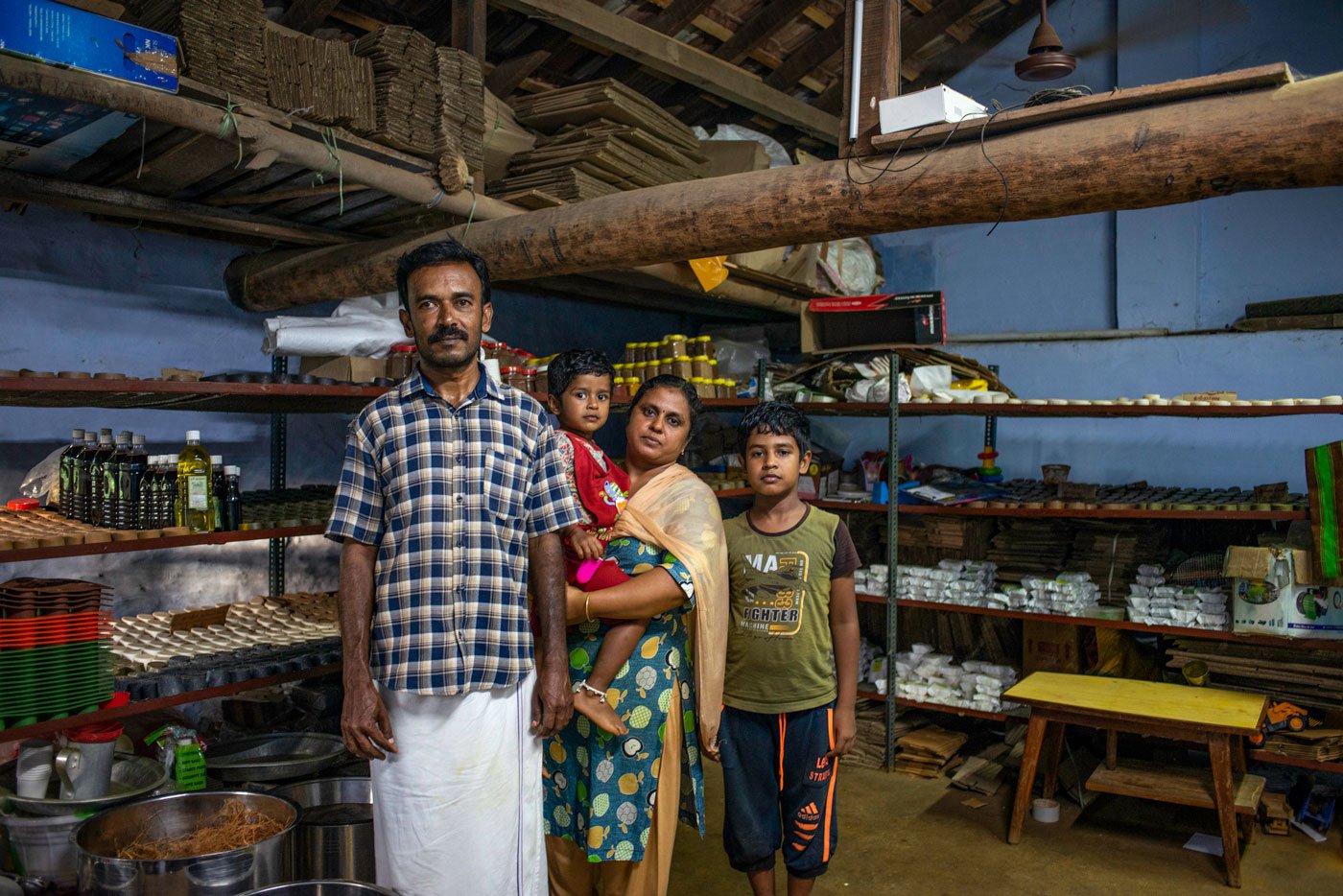
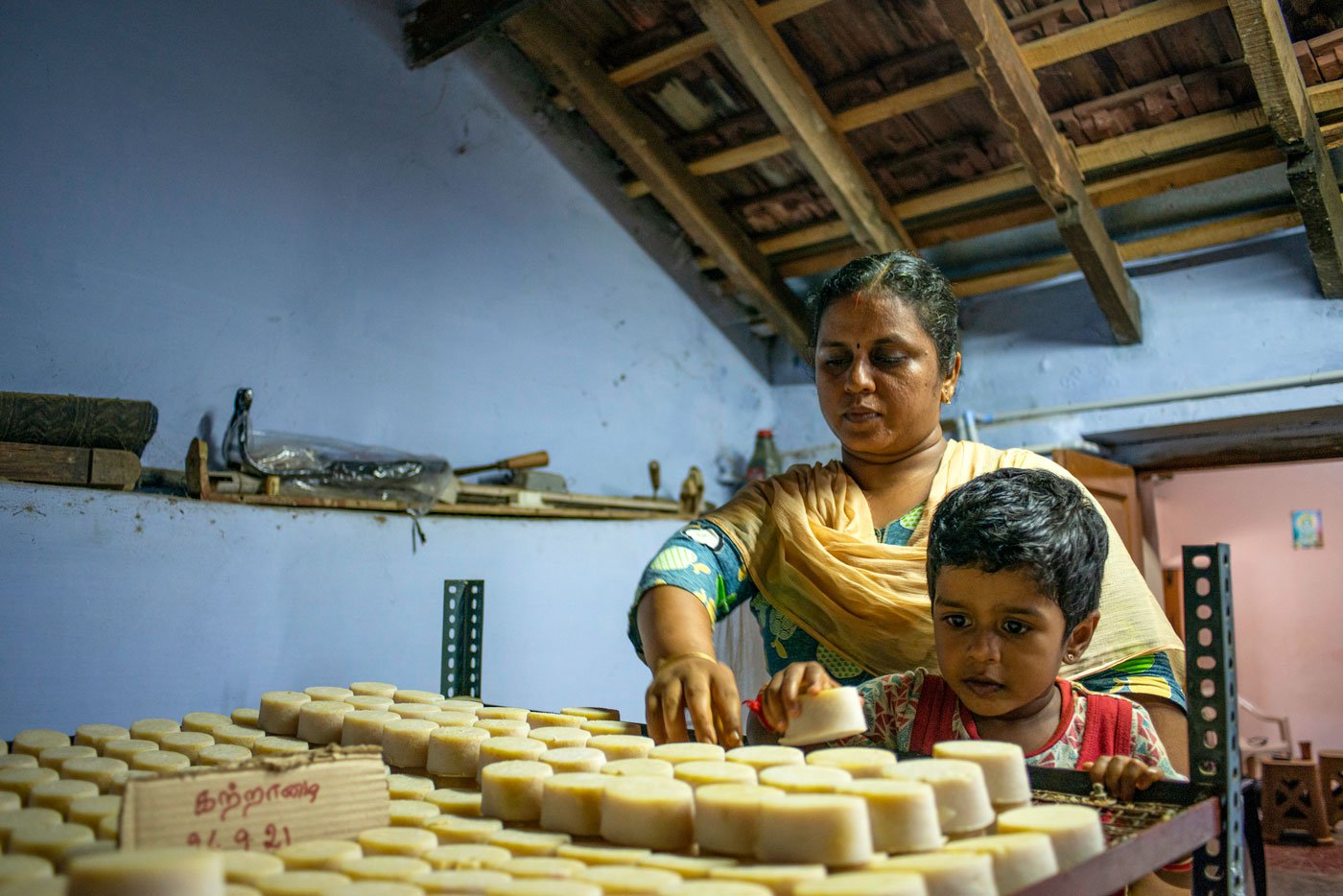
Left: Thiru and Gomathy with their children in the workshop, behind their living room. Right: Gomathy and her daughter shelving soaps in the workshop
Thiru Murthy and Gomathy had an arranged marriage in 2011. He was already an organic farmer – but didn’t know much about value addition. In 2013, he got onto Facebook. It was a post he shared there that made him think about the power of social media, the rural-urban disconnect, and more.
A photo of his breakfast that triggered all of this. People appreciated what he thought was humble food – ragi kali (finger-millet ball) – and he was excited seeing the likes and comments. Encouraged, he began regularly posting details of life on the farm. Everything was recorded online: removing weeds, applying organic fertilizers, and so on.
When he harvested his first turmeric crop, he sold it online. Gomathy started getting involved soon. “Orders for the soaps, oils and powders come to my phone on WhatsApp and I send it to her.” On top of her domestic work and minding their son Nithulan, 10, and daughter Nigazhini, 4, Gomathy handles the entire packing and shipping.
Covid lockdowns and online classes for her son made life harder. During one of our visits, the kids were playing with tadpoles in glass bottles while their dog peered inside those with interest. Another time, they were shimmying up a steel pipe. “That’s what they’ve learnt to do, climb poles,” she sighed.
She has one helper, a woman from the village who pitches in. “From our catalogue, customers might ask for one item from each of the 22 we produce. It’s not easy,” Gomathy says. She runs the house; she runs the show. And smiles more than she speaks.
Thiru’s day is spent convincing at least 10 consumers why his turmeric powder is sold at twice the price of what’s commonly available in the local market. “At least two hours a day I spend in educating the public about organic farming, adulteration and the perils of pesticides.” When he makes a post on Facebook – where he has 30,000 followers – about 1,000 people ‘like’ it, and 200 people comment. They ask questions. “If I don’t answer them, I’ll become ‘fake’ in their eyes.”
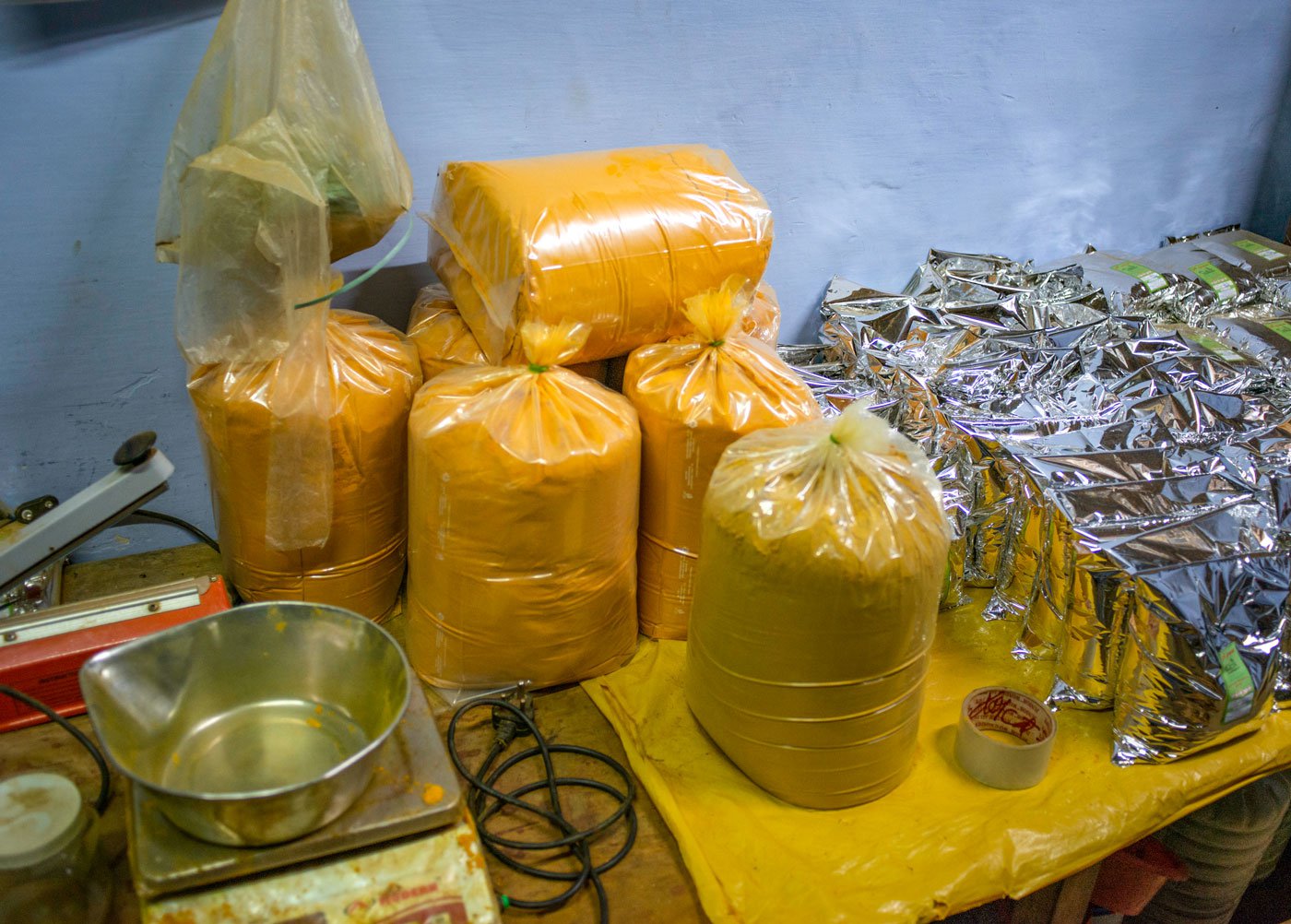
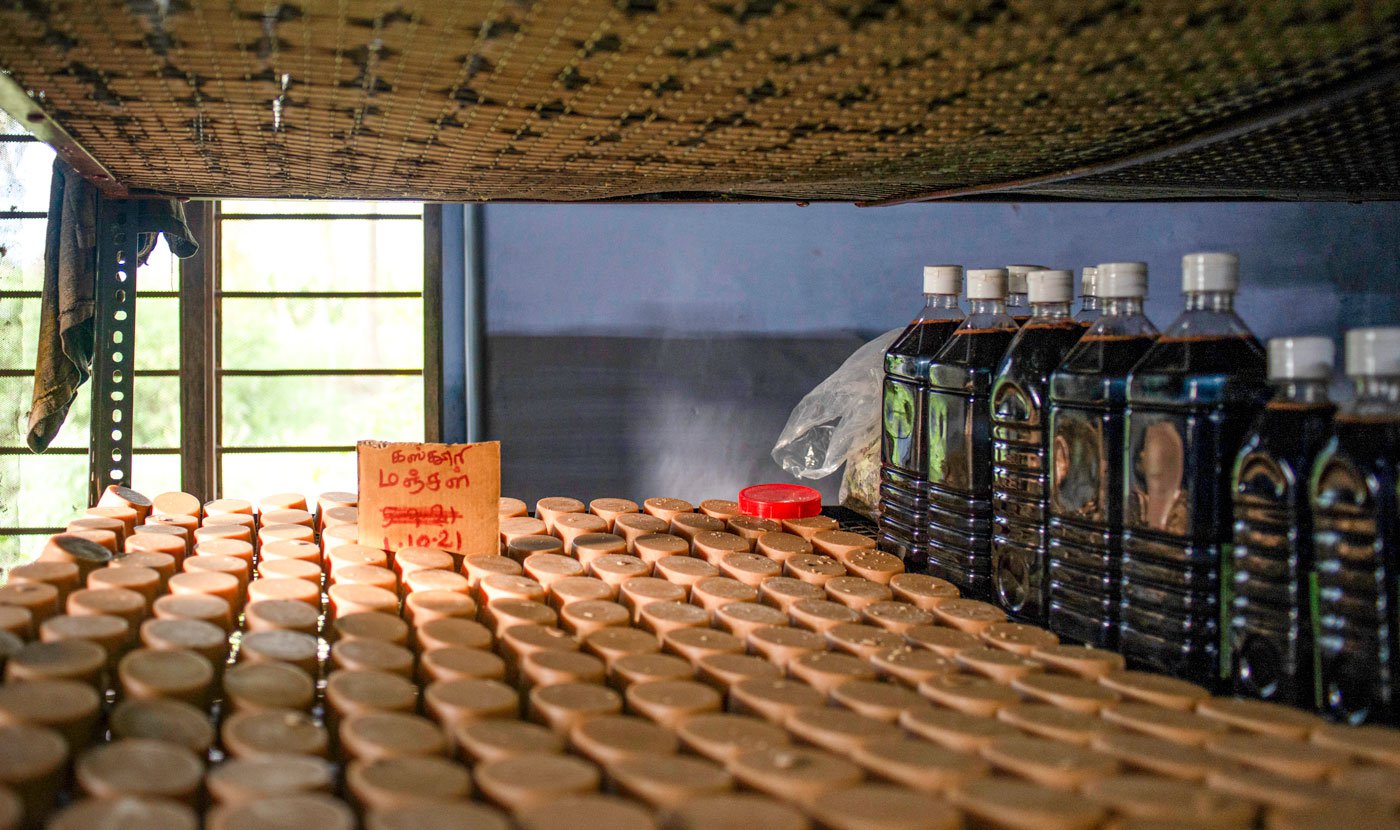
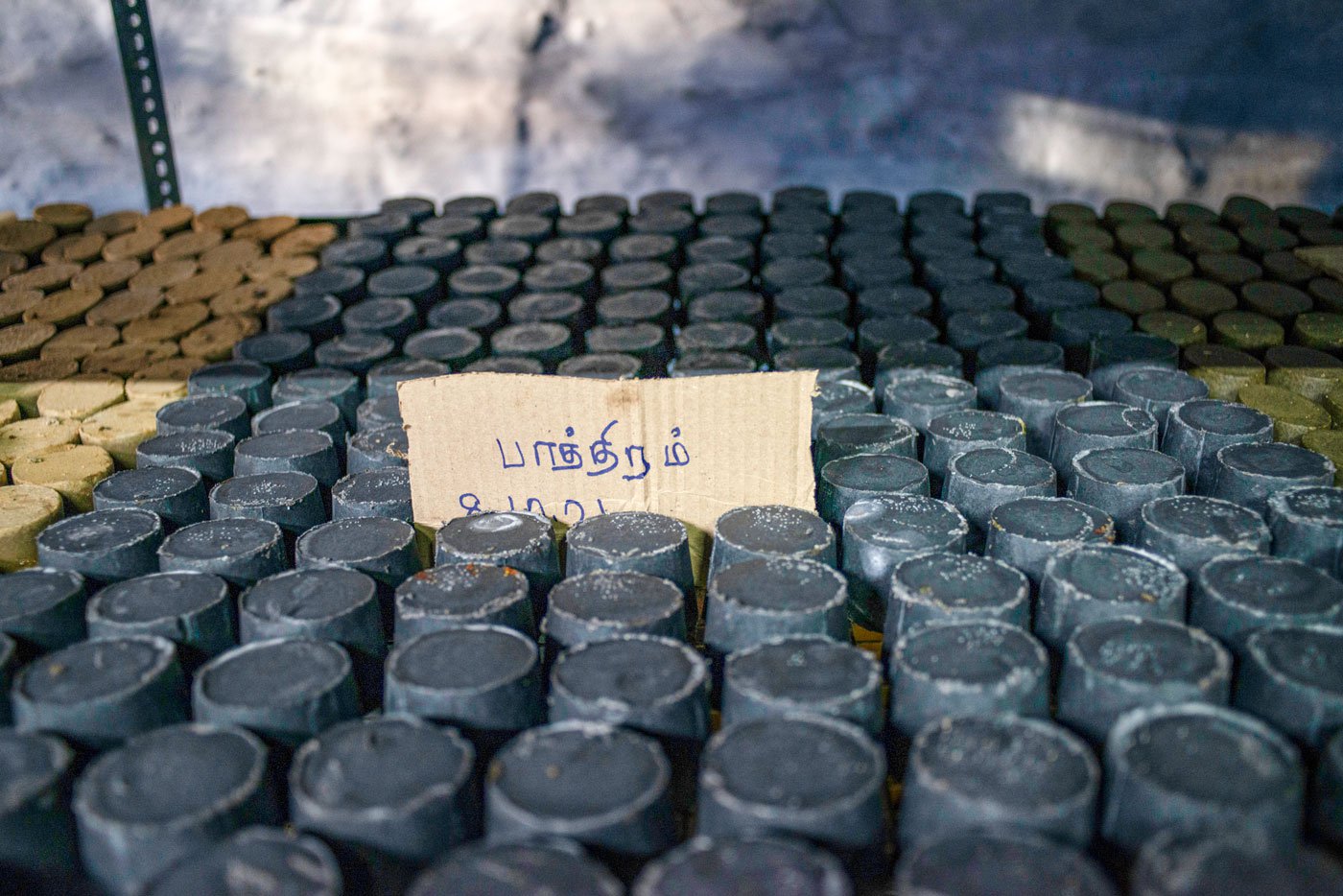
Left: Weighed and packed turmeric powder, which Thiru sells directly through social media. Centre and right: Soaps and bottles of hair oil, ready to be sold
His work around the farm and running his e-business (“I didn’t know it was called an e-business until last month!”) is so hectic that it’s been five years since he’s gone on a holiday. “Maybe more,” Gomathy laughs. “The longest he can take off is six hours. Then he needs to be back home, to his cows and crop and wooden chekku [oil press].”
When there’s a wedding, his mother attends it, his elder brother drives her in their car. Thiru can’t take the time off to attend. “After Covid-19, we save some money,” he jokes. “Usually, we had to drive all the way to Coimbatore for functions. Now we save on those 1,000 rupees of fuel because the functions are off.”
When labourers come to the field, “Amma supervises them. My time goes in all this top work.” During both my visits, Gomathy is busy in the kitchen or their workshop – a high-roofed space behind the living room, with shelves bulging with many kinds of soaps, labelled neatly by type and date. Thiru and Gomathy work at least 12 hours a day, starting at 5:30 in the morning.
They have a deep knowledge of herbs and their properties, and rattle off the names in Tamil. Gomathy also makes fragrant hair oils, soaking flowers and herbs in cold-pressed coconut oil and warming it in the sun. “We test every product before we send it to customers,” she tells me.
The whole family is involved in the business now, says Thiru. It is their unpaid labour that keeps the cost of their products down.
*****
“Amul milk producers get close to 80 per cent of the consumer price. There’s no other equivalent to that model anywhere in the world.”
Balasubramaniam Muthusamy, columnist
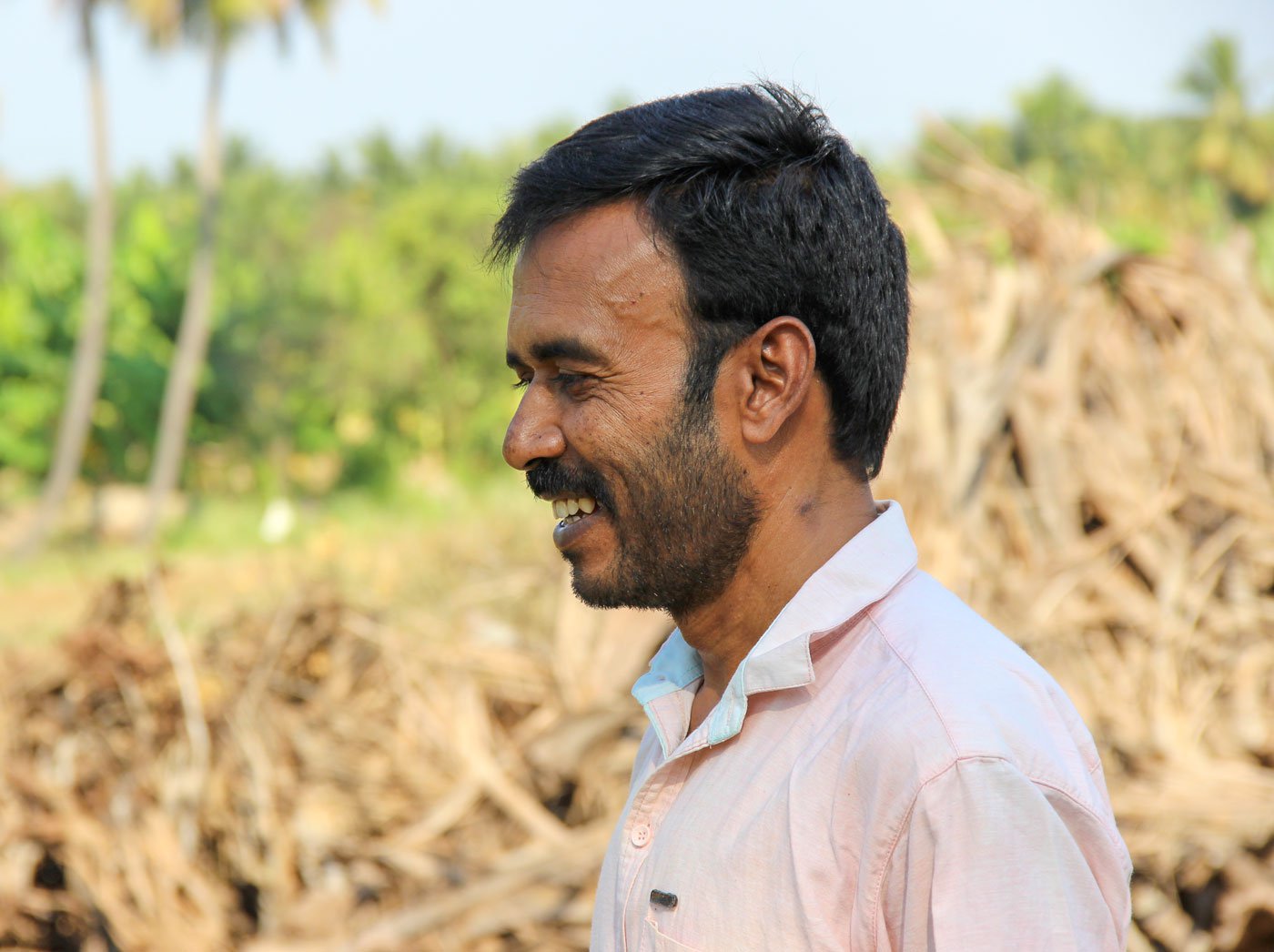
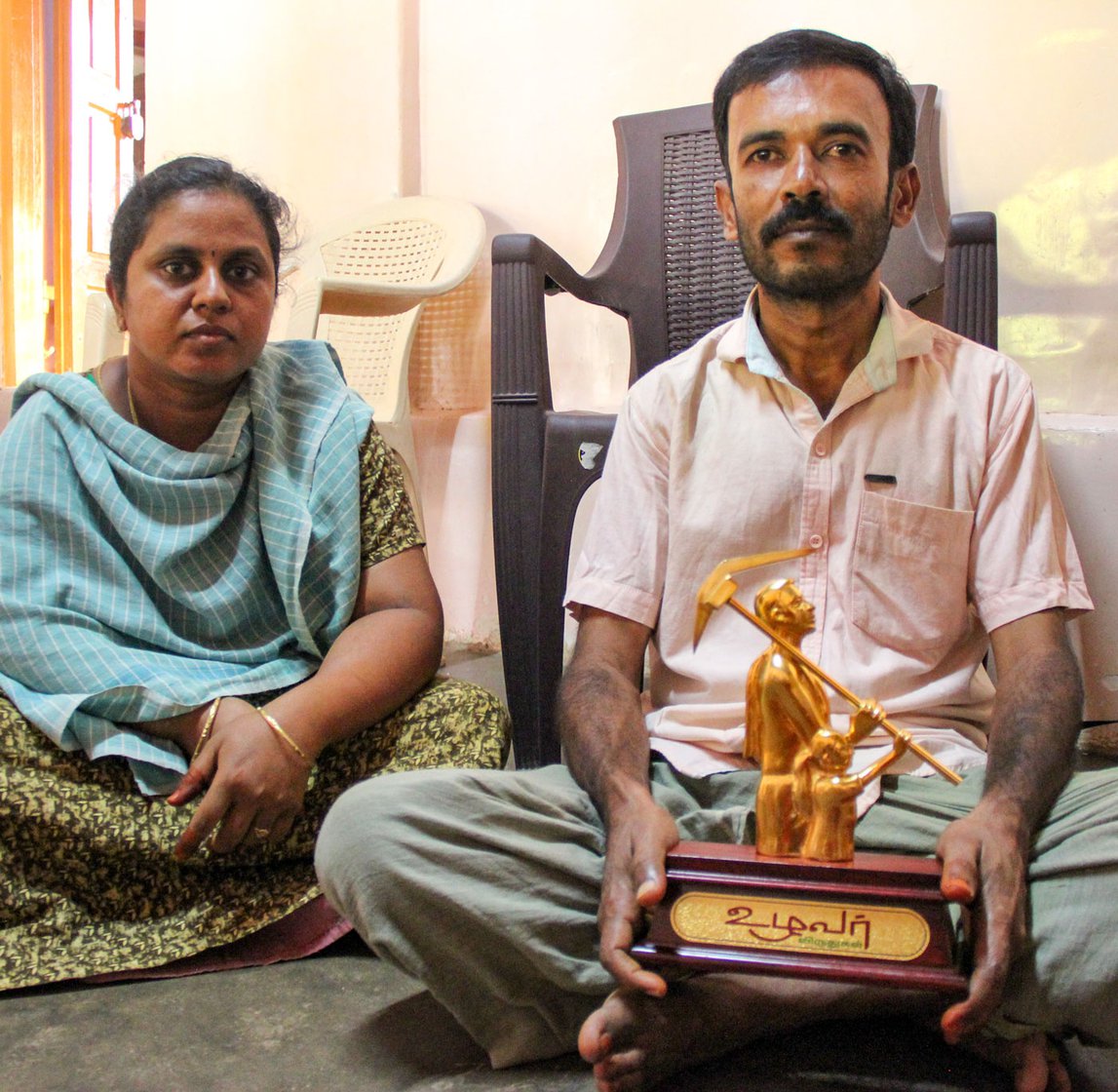
Left: Thiru spends at least two hours a day
educating others about organic farming. Right: Gomathy and Thiru with an award they received for organic farming
Thiru’s model may be a hard one to follow for the average small farmer who leases land or owns a tiny parcel (typically under two acres). It’s unlikely they can significantly replicate his success. Balasubramaniam Muthusamy, a columnist with the online Tamil news platform Arunchol , and from a farming family in Erode district, believes the cooperative model is the only viable solution.
He breaks down the price that is realised by the farmer as a percentage of the price paid by the end consumer. Milk wins, hands down. So does the co-op model, he says, citing the example of Amul. Turmeric farmers get 29 per cent of the Rs. 240 per kilo that the consumer pays. With Amul milk, he says, the farmer gets almost 80 per cent.
The key to success is organising farmers on a large scale, Balasubramaniam points out. “Owning the business supply chain and cutting out the middlemen.” There are problems in cooperatives and farmer organisations, he concedes. “They need to be managed better and that’s the only way forward.”
Thiru insists it is possible to make a good profit growing turmeric – but only if you add value to it. In the last seven years, he’s sold 4,300 kilos of turmeric powder, besides coconut oil, banana powder, kumkum (from turmeric), and soaps. All this would be impossible if he didn’t own land, he points out. (Which reinforces why his model is not replicable by smaller farmers.) “Ten acres would cost four crores! Who will fund that?” His entire business is online. He has a GST number, and accepts payments through G Pay, Phone Pe, Paytm, BHIM and his bank account.
In 2020, actor Karthik Sivakumar’s Uzhavan Foundation conferred an award and a cash prize of Rs. 1 lakh on Thiru for organic farming. And for adding value and selling directly to the consumer. Tamil actor Sathyaraj, who is also from the Kongu region, gave away the prize.
Every year, every small success, only makes Thiru more determined. He cannot lose. “I don’t want to hear the word ‘loss’ from a farmer,” says Thiru, “I have to make it work.”
The author would like to thank Usha Devi Venkatachalam, founder and CEO of Krishi Janani, for her help and hospitality while reporting this story.
This research study is funded by Azim Premji University as part of its Research Funding Programme 2020.
Cover photo: M. Palani Kumar
